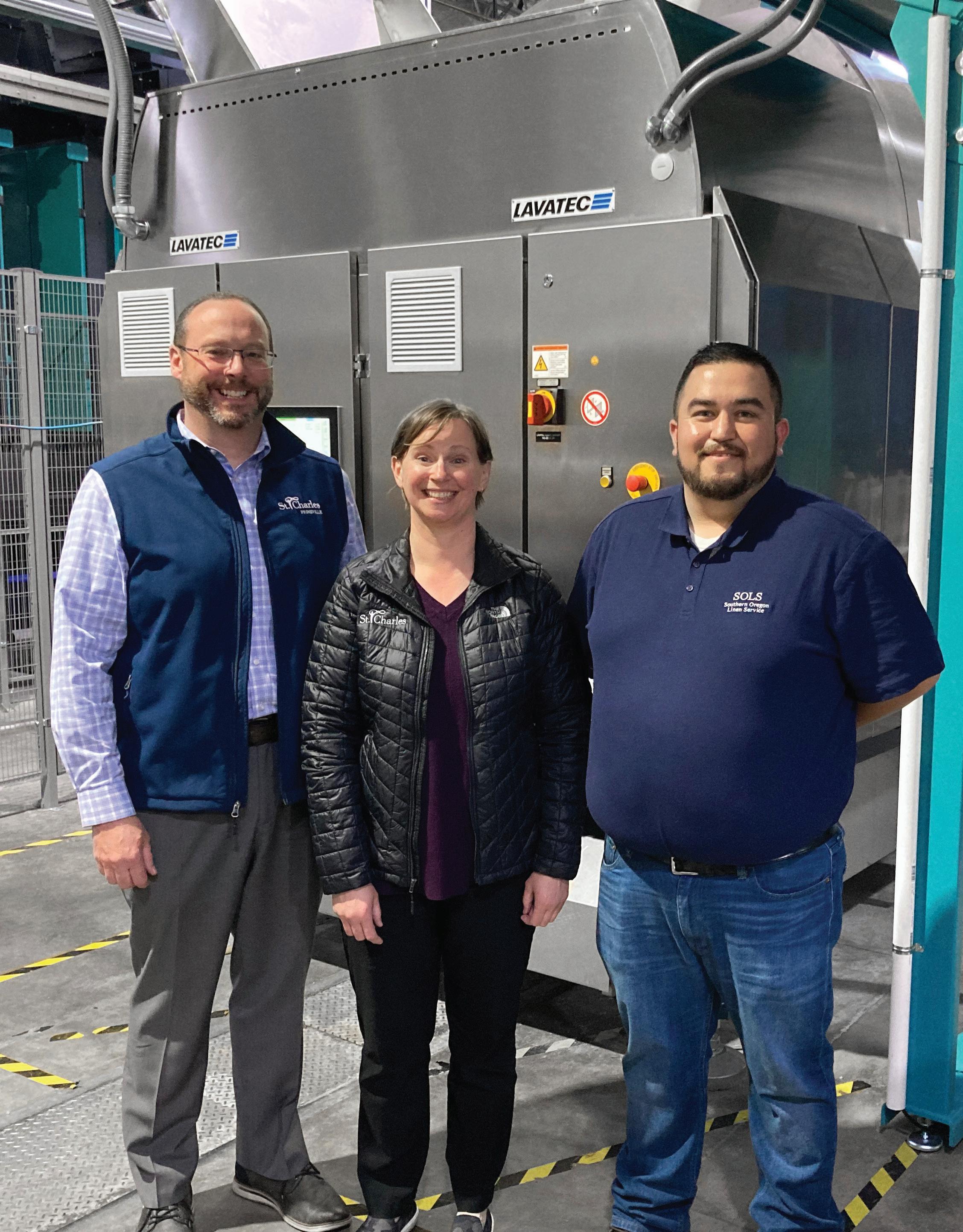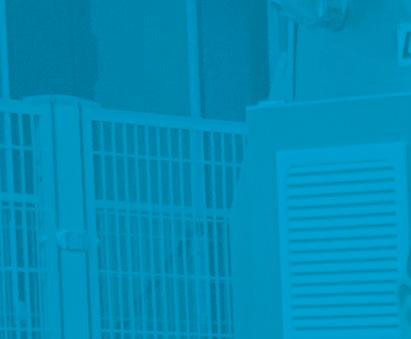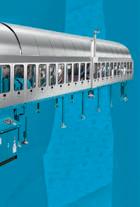Hiring next-generation laundry employees
BY MATT POE, EDITOR
Hiring new employees has been difficult for the laundry and linen services industry for some time.


Even before the events of the past few years, operators were struggling to onboard key personnel such as plant employees, engineers and management.
“Like many industries, hiring remains a challenge,” says Jeff Peterson, sales manager at Spin Linen in Omaha, Nebraska. “We’ve had to re-evaluate everything from compensation to job duties, as well as get
more innovative in our job postings to attempt to stand out.
“There doesn’t appear to be a magic bullet, so we are experimenting and tweaking our approach constantly.”
Fortunately, hiring in the industry is improving.
“There seems to be a positive shift lately,” shares Frank Maresca Jr., vice president of WW Uniforms in Wallingford, Connecticut. “The traction for getting new potential employees is increasing.
“The past has been an absolute struggle—from striking interest and applying to the open job to an employee accepting an interview or the position and the person doesn’t show up at all.
“Nevertheless, in recent months there has been an increase in applications and acceptance of the said available jobs.”
“We have started to see our labor pool open up a bit over the last couple quarters,” agrees Ben Warnecke, a fourth-generation family member and general manager at Plymate Inc. in Shelbyville, Indiana.

“Incenting and promoting our employee referral program has resulted in quite a few great hires for Plymate in recent years. We are laser-focused on onboarding and employee engagement once we make a hire, so, thankfully, we don’t find ourselves with more than a couple openings very often.”
Kleen Kraft Services in Commerce, California, has also had success with employee referrals onboarding qualified, dedicated workers.
“In general, we have very little turnover,” says Marilyn McCarty, marketing manager. “Many of our staff have been here for over 10 years and some as long as 40 years. I think this speaks to the type of operation that we run, the pay and benefits offered, and the feeling of belonging.
“Most of our new hires come in as refer-

rals from current employees—drivers, sales reps, office staff—have all come in as referrals. With referrals like this, we can anticipate that the worker will be qualified and that they have a good idea of the work expected.”
While there are signs of improvement in the laundry labor market, many laundry operators still face difficulties.
“Hiring new employees remains a challenge for Paris,” says David Stern, president and CEO, Paris Companies in DuBois, Pennsylvania. “We are getting enough applications for most hires; however, the quality of the applicants has deteriorated from pre-pandemic.”

A major challenge is enticing younger employees to enter the laundry and linen services industry. Many don’t see it as a viable career option and aren’t prepared for the effort needed to succeed.
And some aren’t even aware that the laundry industry exists.
So, how can a laundry operator attract the next generation of laundry employees?


HUMAN RESOURCES PERSPECTIVE

For the textile services industry to get the attention of younger employees, it needs to better understand who the next generation is and what it is looking for in terms of employment and career opportunities.
Elissa Jessup, HR knowledge advisor for the Society for Human Resource Management (SHRM), shares that the organization has researched what younger workers are looking for in a workplace.
For Generation Z (born between 19972012), SHRM has compiled a “top 10” list of work qualities they are seeking.
“They’re looking for flexibility, peer
Healthcare Linen Services Group acquires Linen King




ST. CHARLES, Ill. — Healthcare Linen Services Group (HLSG), a provider of healthcare laundry services headquartered here, reports it has acquired Linen King, based in Tulsa, Oklahoma. A portfolio company of York Capital Management’s private equity group, HLSG provides services in the Midwest and Central United States.
As part of the transaction, Seaport Capital, a New York-based private equity firm that acquired Linen King in 2019, will receive shares in HLSG.
Terms of the transaction were not disclosed.
Founded in 1999, Linen King serves approximately 460 customers across seven facilities in five states. It processes approximately 100 million pounds of healthcare laundry annually at facilities located in Arkansas, Oklahoma, Missouri, Kansas and Tennessee.
Chris Corcoran, Linen King’s chief executive officer, will remain with the business and serve as the regional chief operating officer of HLSG.
Following this transaction, HLSG will operate 21 linen processing plants across six regional brands: Logan’s Linens, Logan’s Uniform Rental, Superior Health Linens, Textile Care Services, Reino and Linen King. These brands and facilities process approximately 350 million pounds of healthcare linen on an annual basis for nearly 1,000 customers in 19 states.
The Newspaper of Record for Laundry & Linen Management February 2023 • Volume 49, Number 02 www.americanlaundrynews.com
Experts share insights into how operators can attract, and retain, younger staff members
(Photo: © luckybusiness/Depositphotos)
See NexGen on Page 6 LATE NEWS
Cintas’ electric vehicle pilot program hits the road
CINCINNATI — Cintas Corp. reports it recently launched its electric vehicle pilot program, which to date includes almost 20 vehicles from multiple manufacturers.
Cintas operates one of the largest corporate fleets in North America with almost 14,000 commercial vehicles deployed throughout the United States and Canada, and it’s a significant source of the company’s Scope 1 (direct) greenhouse gas (GHG) emissions.

Cintas acknowledges the importance of transitioning its fleet as it continues along its Path to Net Zero.
“Our ability to remove vehicles powered by fossil fuels from our fleet and introduce vehicles that run on renewable or alternative fuels will be an important factor in our ability to achieve our Net Zero ambition and reduce our carbon emissions intensity,” says Christy Nageleisen, Cintas vice president of environment, social and governance (ESG) and chief compliance officer.
“When we meet with employee partners in the field, the EV pilot program is always near the top of their interests. There’s a lot of excitement and anticipation throughout the organization about our EV program, and we’re eager to see how these pilot vehicles perform while out in service and running our routes.”
HITTING THE ROAD
Cintas’ EV pilot program officially launched in early 2022 when the first vehicle was deployed in the Los Angeles area.
To date, 17 different vehicles from five different manufacturers are or have been included in
the pilot program with additional units in Cincinnati, Detroit, Minneapolis, Los Angeles, San Francisco, San Jose and Seattle.
EVALUATING EVS IN ACTION
The pilot program will help Cintas evaluate the performance, durability and reliability of various EVs in a variety of business, weather and road conditions.
Using the vehicles in real-world conditions is intended to help the company better understand the expectations, benefits and potential challenges of EVs in its unique route-based business.
“When we originally decided to pilot the (electric) vehicles, we wanted to test markets that were cold, hot, that had snow—that had all the different weather conditions—so that we ensured we got the right vehicle for the right industry,” says Mark Bolen, Cintas vice president of quality and engineering, whose group oversees the company’s fleet.
“Up until this point, the technology wasn’t out there to start a program like this. Over the last two or three years, they’ve really come along to where the technology’s there.”


Cintas’ fleet department works closely with various original equipment manufacturers (OEMs) to identify additional opportunities, new technologies and future use cases that can maximize the effectiveness and performance of the EVs in the pilot program.
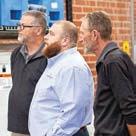
“We are constantly talking to our vendors, meeting weekly on conference calls, sharing information, then our team—the fleet team—actually has phone calls with our operations to understand exactly what’s transpiring

throughout the week,” Bolen says.
“We’re making sure the vehicle is performing where we want it to, and then we’re constantly making that range go out a little bit further, and a little bit further, a little bit further.”
WHAT’S AHEAD
As 2023 approached, Cintas planned to procure and deploy additional EVs around its business footprint.
“We have a unique business, and our fleet has unique use cases, and we expect our fleet will continue to include different vehicle models, including various light-, medium- and heavy-duty units to meet the needs of our business,” Bolen says.
“As more options and technologies are developed, and more OEMs enter the commercial EV and alt-fuel markets, we expect to grow the pilot program in both quantity and scope.”
Additional grant funding has already been secured through different government initiatives and
the company has plans to expand the current roster of EVs with as many as 50 additional units in the next calendar year.
Cintas also plans to pursue additional opportunities to test and deploy new technologies from different manufacturers as they become available.

Cintas leaders are also monitoring innovations and developments in other types of alternate-fuel vehicles.
Along with its ambition to achieve Net Zero GHG emissions by 2050, the commercial vehicle industry will also continue to evolve with new technologies and capabilities.
Bolen notes that Cintas remains open-minded about the types of vehicles the company will choose for its fleet over the long term and that the company is anxious to evaluate new renewable and alternate-fuel vehicles when they’re available.
“Who knows what the new technology will be in the next 5, 10, 15 years?”
Publisher Charles Thompson
Phone: 312-361-1680
E-Mail: cthompson@ ATMags.com
Associate Publisher/ National Sales Director



Donald Feinstein
Phone: 312-361-1682
E-Mail: dfeinstein@ ATMags.com
Editorial Director Bruce Beggs
Phone: 312-361-1683
E-Mail: bbeggs@ ATMags.com
Editor Matt Poe
Phone: 866-942-5694
E-Mail: mpoe@ ATMags.com
Production Manager
Mathew Pawlak
Digital Media Director Nathan Frerichs
Phone: 312-361-1681
E-Mail: nfrerichs@ ATMags.com
Advisory Board David Barbe
Janice Ayers Davis • Nick Fertig Deana Griffin • Cecil Lee Edward McCauley Jim Slatcher
Main Phone: 312-361-1700
Fax: 312-361-1685
Subscriptions 847-504-8175 ALN@Omeda.com
www.americanlaundrynews.com
2
FEBRUARY 2023 | American Laundry News www.americanlaundrynews.com MEMBERSHIPS American Laundry News (ISSN 1091-9201) is published monthly. Subscription prices, payment in advance: U.S. 1 year $50.00; 2 years $100.00. Single copies: U.S. $10.00. Published by American Trade Magazines LLC, 650 West Lake Street, Suite 320, Chicago, IL 60661. Periodicals postage paid at Chicago, IL, and at additional mailing offices. POSTMASTER, Send changes of address and form 3579 to American Laundry News Subscription Dept., 125 Schelter Rd., #350, Lincolnshire, IL 60069-3666. Volume 49, number 2. Editorial, executive and advertising offices are at 650 West Lake Street, Suite 320, Chicago, IL 60661. Charles Thompson, President and Publisher. American Laundry News is distributed selectively to qualified laundry and linen management and distributors in the United States. © Copyright AMERICAN TRADE MAGAZINES LLC, 2022. Printed in U.S.A. No part of this publication may be transmitted or reproduced in any form, electronic or mechanical, without written permission from the publisher or his representative. American Laundry News does not endorse, recommend or guarantee any article, product, service or information found within. Opinions expressed are those of the writers and do not necessarily reflect the views of American Laundry News or its staff. While precautions have been taken to ensure the accuracy of the magazine’s contents at time of publication,
editors, publishers
agents
accept responsibility for damages
injury which may arise therefrom.
(Photo: Cintas Corp)
neither the
nor its
can
or
01 Hiring Next-Generation Laundry Employees Experts share insights into how operators can attract, and retain, younger sta members 04 Mitigating Rising Energy Costs Columnist-at-Large Tommy Cocanougher shares options to help contain energy usage levels in laundry plants 10 Staying Ahead of the Breakdown Curve Preventive maintenance laundry operations can do with the plant running and with minimal downtime impact or parts costs 12 Reinvigorating Laundry Facility Safety In this issue, the Panel of Experts answers a question about how to re-emphasize safety in operations 14 Supplier Experience, Relationship Strengthens Customer Value Rental Uniform Service touts partnership with UNX-Christeyns to create customer-pleasing wash formulas 16 Product Showcase Small-capacity washer-extractors 19 Classified Advertising 20 Source Directory 23 Trade Ticker 23 Calendar of Events INSIDE:
Milnor has a better solution through dilution.
When Milnor introduced PulseFlow® technology, CBW® washing was thrust into the future. The idea of balancing time, temperature, mechanical action and chemistry was missing one critical piece of the pie – DILUTION through the efficient use of water.
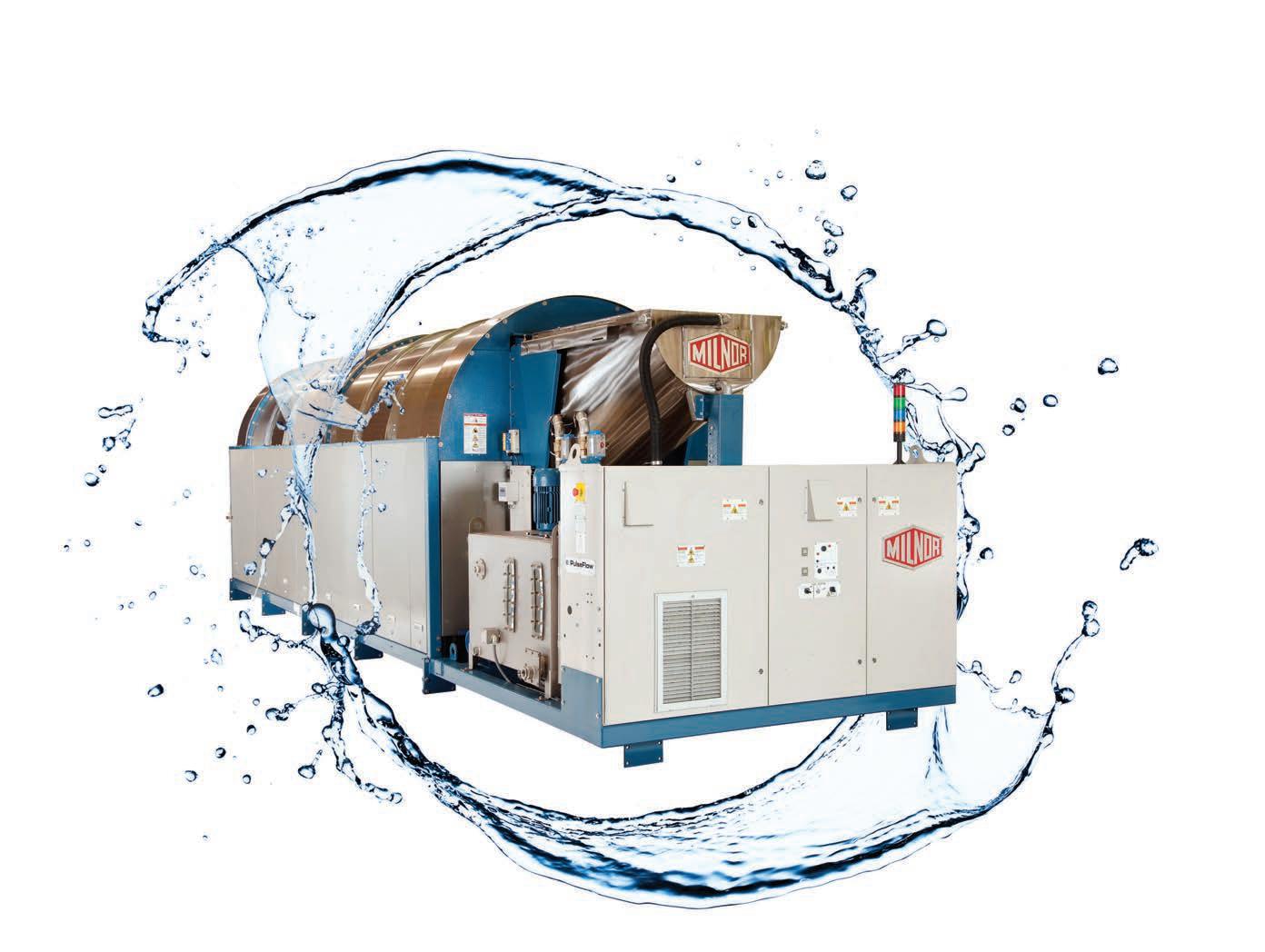
PulseFlow combines the innovative RecircONE® fast wet down and chemical immersion in the first module with standing bath washing in every spacious process module. Thorough and efficient dilution occurs by way of intermittent high velocity counterflow rinsing and traditional True Top Transfer.
The result is hygienically clean linen using less water (as low as 0.3 gallons per pound/2.5 liters per kilogram) and less energy as proven time and again by hundreds of PulseFlow tunnels in a variety of laundry applications worldwide.
Contact an authorized Milnor distributor or call 504-712-7656 to find out more.
www.milnor.com

*PulseFlow®, CBW® and RecircONE® are Pellerin Milnor’s registered trademarks.
Finding new employees
There was a time in my career, about 15 years ago, when I was involved in hiring (and firing) employees. It was not a favorite part of the job for me.
First off, when you advertise that your publication is looking for a writer or editor, the floodgates open on resumes.
It seemed like anyone who had even looked at the alphabet applied. Not that they knew how to use it for how many misspelled words I read on cover letters and resumes.
And I can’t begin to tell you how many were “imaginative,” “creative,” “artistic” and “could write about anything.”
After sifting through the piles and selecting a few I hoped might work, it was time for interviews.
One person spent the time chewing gum like a cow, staring at their shoes and giving one-word answers.
Another tried to wow me with their knowledge of the trade industry of the publication (travel)—they weren’t even in the right zip code.
Yet another kept asking about the possibility of publishing poetry—in a trade magazine.
I can’t imagine what you as a laundry operator are going through these days, especially when it comes to hiring and working with younger employees.
Fifteen years ago, their attitudes toward work baffled me.
But without younger employees, the industry is going to have an uncertain future.
That’s why this issue’s cover story is about hiring the next generation of laundry employees. I spoke with human resources and laundry operation experts to gather information to help with your search.
To help you keep operating, the second feature (page 10) is about preventive maintenance. There’s also a Product Showcase on page 16 that highlights small-capacity washer-extractors.
All this and much more is in the pages of this issue to help everybody keep it clean!
Alsco orders 30 batteryelectric step vans from Xos
LOS ANGELES — Xos Inc., which provides fleet services, software solutions and manufactures Class 5 through Class 8 battery-electric commercial vehicles, reports it has secured a purchase order for 30 of its 100% battery-electric step vans from global uniform and linen rental services company Alsco Uniforms.

The 30 vehicles will be split and deployed across several of Alsco’s California laundry processing facilities as follows: nine vehicles to Santa Rosa, nine vehicles to San Jose, seven vehicles to San Francisco, three vehicles to Concord and two vehicles to Los Angeles.
“We’re thrilled to add Alsco to the Xos ecosystem and expand our footprint within the uniform and linen services industry,” says Jose Castañeda, vice president of business development at Xos.
Mitigating rising energy costs
While we have always had fluctuating energy costs in our businesses, it seems lately there is a whole new level of price escalation.
No matter what we do to contain costs, the industrial and commercial laundry industry is seeing dramatic impacts on profitability like rarely before. Mark it up to general inflationary pressures, polar vortexes, aging infrastructure, increased governmental regulation or some other cause, it just seems to be getting out of control.
There are limited options to control per-unit costs—these are often regulated by local entities that control services like water and sewer, or perhaps markets where fuel oil and natural gas are impacted by weather events.
There are more options available to us to contain usage levels in our plants, and these can impact your P&L (profit and loss statement) positively. Let’s unpack some of these key areas where we can make a difference in the bottom line.
PER-UNIT COST CONTROL
Check with each utility supplier and assure your business is on the correct rate schedule. Getting on an alternate rate schedule can impact your per-unit cost in a big way.
In its most recent sustainability report, Alsco Uniforms outlined its latest efforts and results in building a more sustainable business, including a reduction of water use by 50% over the last 10 years, the elimination of paper waste by implementing an online account management system and investment in American-made fabrics with life cycles of up to 80% longer than imported linens.

“We are thrilled to add the Xos step vans to our nationwide fleet,” says Tim Stuewer, director of operations support at Alsco. “The move to fleet electrification is an important pillar of our ESG initiative.
“We’ve been impressed by the vehicles that Xos has built and we’re looking forward to using them to make uniform, linen, floor mat, first aid and restroom supply deliveries to our many customers in California.”
ARE YOU RECLAIMING ALL THE WASTE HEAT YOU CAN? BOILER STACK ECONOMIZERS, WASTEWATER HEAT RECLAIMERS AND MAKE-UP TANK VENT CONDENSERS CAN HELP RECLAIM HEAT. MAKE SURE THEY ARE CLEAN AND WORKING PROPERLY.
Assure you are auditing your bills for each utility supplier each month and are checking their billed usage levels against your daily meter readings (more on that later). There is no substitute for understanding your billing and rates.
Consider utilizing the services of an energy management firm. They will usually offer services including bill auditing, payment processing and negotiation of new utility contracts that can help you keep costs in check.
They’ll also educate you on how the utility system works, and that is important to understand.
IN-HOUSE USAGE CONTROL
Use the usually complimentary services of your utility suppliers to audit your site and offer ideas to reduce energy consumption. Ask about rebates for work that you do based on their recommendations.
Turn the lights off! How often do you walk into your plant on a weekend, when it is quiet and no work is in play, and the night shift left on all the lights? Train your employees to keep the lights off when not needed and when they leave. Consider timers, motion detection actuation and LED lighting retrofits to help contain lighting costs.
As mentioned above, be sure your team is taking daily meter readings and doing the math to catch any spikes in usage. This may be particularly noticeable in water meter readings where it can give you early notice of a leak in the line or a leaking drain on a washer.
It gives you the data to assure that the utility billing office is charging you for the correct amounts used.
• David Griggs: New Year, New Goals, New Challenges

OUR SISTER WEBSITES
From AmericanDrycleaner.com:
• Dry Cleaners’ Predictions for 2023
• Counting Down 2022’s Top 10 Stories WE
From AmericanCoinOp.com:
• Entrepreneur Pursues Opportunity with Love ...
• Girbau Group Appoints Joris as Oasis Laundromat Owners ...
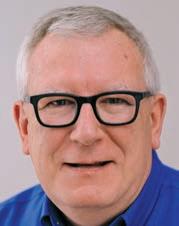

Are you reclaiming all the waste heat you can? Boiler stack economizers, wastewater heat reclaimers and make-up tank vent condensers can help reclaim heat. Make sure they are clean and working properly.
Water reuse systems come in handy when you have the space to place the tanks and pumps. Planning for these systems should include installing a split trench and washers that have two drains so you can direct the flow of potential re-use gallons. Treated water from your DAF (dissolved air floatation) may also be redirected to re-use.
See Column on Page 18
4 FEBRUARY 2023 | American Laundry News www.americanlaundrynews.com
From The Editor’s Desk
January 15. NEWS • Alliance Laundry Systems Distribution Relocates Texas Office • Maxon Completes Construction on Second Manufacturing Plant
CITY Laundering Acquires Lake Superior Laundry
In Memoriam: Lee Ekola, Kannegiesser ETECH
Huebsch Services Receives Award for Sustainable Practices
to Laundry/Linen Services Longevity
on
Update, Strategies
Top Stories Appearing on americanlaundrynews.com for the 30 Days Ending
•
•
•
COLUMNISTS/FEATURES • Secrets
• Reflecting
2022, Looking Toward 2023 • Laundry Operation Supply Chain
COLUMNIST AT LARGE Tommy Cocanougher
MATT POE
(WE) = WEB EXCLUSIVE


Visit www.monarchbrands.com or scan the QR code to access our live inventory 24/7/365 2022 Home Textiles Today 2022 Reader Rankings Award Winner Best Table Linens Best Kitchen Textiles Jeff has been looking for bistro napkins for 3 hours... Jeff is getting upset. Don’t be like Jeff. 1. Browse our textile inventory in real time on monarchbrands.com. 2. Get your order shipped the next business day. 3. Put the phone down.
coaching, teamwork, diversity, work-life balance, development, growth, social awareness, mentorships and job rotation,” Jessup says.
She says younger millennials (born between 1981-1996) are looking more for performance-based compensation, flexible schedules and a flexible location—whether that’s remote or maybe a hybrid-type situation flexibility.
“Also being able to have marketable skills, so training,” Jessup continues. “Having access to decision makers regardless of what type of level or position they may be in. They want to be able to build those relationships with management and higher leaders in an organization.
“They also want to have a clear area of responsibilities in their job and then a chance to be creative as possible
“And there was something that I thought was interesting, its Gallup survey data, but there were three things that the young millennials and Gen Z both agreed on what they wanted: an organization that cares about their well-being, organizations and leadership that is ethical, and an organization that is diverse and inclusive of all people.
“And the last one wasn’t just an employer having a program saying that they value diversity, but they can actually see those results—you can see the difference in those organizations that do that.”
From Jessup’s experience and studies about the younger generations and how they work, she has found that they want their position to matter. They want it to be part of something bigger than themselves.
“So, if an employer can relate their job to a bigger emphasis and being a part of something bigger than themselves, they want to do that,” she points out. “As opposed to the older generation, where they stayed with the same employer most of their career and were mostly looking at financial stability, things like that.
“The younger generation is a bit more different in that they want to feel passionate about what they’re doing. If an employer can connect what they’re doing and they can feel passionate about that, I think that would make a big difference in what they’re doing.”
This also means that younger employees will likely not remain with an employer for their entire career.
“I believe the data on the younger generation is three to five years with the same employer versus the older generation, which is obviously a lot longer than that with an employer,” Jessup says.
“It is looking that way with our research and especially given how many employers don’t have pension plans anymore. Employees can take their 401k and move that anywhere. They see the value in not only promotion opportunities elsewhere but raising their salary elsewhere.
“There’s not so much that commitment to one organization.”
That’s not to say that all young employees are going to stay with an employer for three to five years, but Jessup suggests that employers need to consider building career paths for younger workers.
“If they can see where their career path is going with a certain organization, they may be more likely to stay with that
employer longer,” she points out.
“If an employer creates mentorship opportunities, connecting with someone who is in the direct career field they want to be in, or if there is a different career field within the same organization where they can learn from, having those robust types of training and or leadership programs can often help combat that shorterterm commitment from the younger employees in the laundry operation.”
When it comes to attracting younger employees to either management-level positions or plant operations, Jessup says it depends on the education level of the workers.
“This is more anecdotal, but someone with a college degree isn’t going to want to work in a plant but it can help an employer in general, I would say, to target high school career fairs or maybe even community colleges if maybe they aren’t sure if the four-year degree is for them,” she says.
“Kind of target the right job based off the education level that an employer is looking at.”
But still, even in a plant setting, younger workers will be looking at advancement, being more a part of the team and understanding the whole of what’s going on.
“I think another thing to consider is focusing on well-being,” Jessup shares. “Whether that’s providing an employee resource or just the overall well-being of employees, they want to feel like their organization cares for them.
“I think also having a healthy work-life balance is important. That can be challenging, depending on the type of industry, of course, but integrating work and life and being able to manage that is important to the younger employees as well.”
Ultimately, she says it’s vital for younger workers to have managers who not only provide feedback but also inform them of what’s going on within the organization.
“We have some data for employees, and 61% of millennial workers are engaged when their manager, or supervisor, informs them of what’s going on in their organization,” says Jessup.
“Just keeping employees in the loop, and, again, connecting how their role impacts the organization overall, can help with that engagement.”
The initial challenge, though, is attracting the attention of the younger generations to consider employment in the laundry and linen services industry.

Jessup says employers need to update their recruiting methods for younger workers.
“One idea in recruiting methods is updating the technology,” she says. “Text alerts for job openings. Creating videos for a day in the life of working for either a specific job or a specific company to give an idea of what it’s actually like to work there.
“Make sure the job advertisements are interesting. That they grab the reader’s attention. More likely than not, if the younger applicant is reading something and it’s not engaging right away, they’ll probably move on.
Jessup says that many online job descriptions use a lot of copy-and-paste from job descriptions on file.
“The key point to keep in mind is that a job ad should not just be a copy-paste job description,” she says. “People lose interest very quickly.
“What you could do is the first paragraph, try to make it more interesting in terms of describing maybe the team environment or what they would be doing. Asking questions like, do you want to be part of an innovative team working on X, Y or Z; do one, two or three; do these things appeal to you?
“Thinking outside of the box of how you can engage a reader in seeing this isn’t
just any job ad. They’re trying to describe what this position is doing.”
Finally, Jessup says it’s important to streamline the overall recruitment process to reach younger employees.
“Younger workers are more likely to apply to a job with their phone versus a desktop like older generations,” she says. “So, it’s important to make the process easy, efficient.
“Specifically, no one wants to upload their resume and then have to fill out the exact same information on an application. That’s probably the biggest complaint that I’ve heard.
“That’s an area that I think employers could benefit from in at least the recruitment-type process.”
LAUNDRY OPERATOR INSIGHTS
Laundry operators agree with the insights Jessup shares about younger workers, in general, when it comes to laundry and linen services attracting nextgeneration employees.
“In today’s environment, we must effectively convey the full package/opportunity to younger candidates when recruiting,” Warnecke points out.
“With an expectation of immediate gratification and plenty of options, we need to be able to map out a plan for possible upward mobility, promote the strong work-life balance we can offer, and focus on effective engagement and recognition once we have them onboarded to get the most out of each one.”
Maresca says, “The younger generation looks deeper into your company, not so much for what you offer on paper but for what others think of you—for scalability, company culture and opportunity for their resume.
6 FEBRUARY 2023 | American Laundry News www.americanlaundrynews.com
Continued from Page 1 ➢ Page 8
NexGen
Mentorship opportunities and robust training can help next-generation employees see the value and longevity of a career in laundry. (Image licensed by Ingram Image)
YellowGo® removes unwanted dye from fabric.





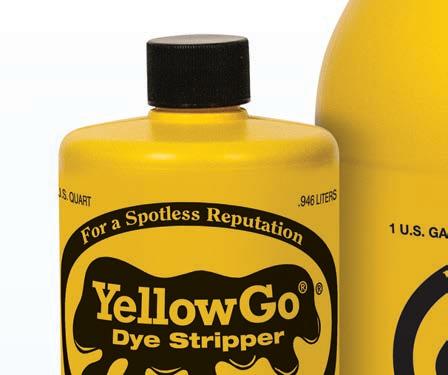
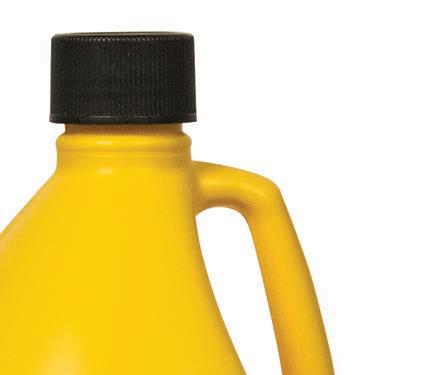

Results on whites are excellent. On colors, you have nothing more to lose and everything to gain by trying YellowGo. YellowGo may take out color you want to keep. But if it removes the unwanted dye without damaging the underlying color, you win! You won’t have to pay for the dye-stained garments and you won’t disappoint your customers.
So use YellowGo to keep your customers happy and keep them coming back.



For more information visit AlWilson.com or call us at 800-526-1188 or 201-997-3300


NexGen
“The work that our industry provides is not glamorous and requires leg work, lifting and early hours. Some of the major points we use are our involvement in green sustainability, community enrichment, four-day work weeks, great benefits, company outings, a relaxed family atmosphere, we have been in business for 99 years, and, of course, very competitive pay.”
“Younger folks have lived through some tribulations when it comes to the jobs,” Peterson shares. “They’re naturally not as inclined to trust employers, who they have seen treat people close to them as expendable. So, they’re a bit more jaded and cynical—perhaps rightfully so.
“Given that, you’ve really got to make an emotional appeal to them that they’ll be valued, treated with respect and part of a team. They like to belong to things that give them purpose, so appealing to the big picture and explaining the ‘why’ beyond simply telling them what their job duties are is one way to accomplish that.”
Stern agrees, “Younger employees’ expectations are different than past generations. They want upward mobility quicker without having to prove themselves.
“They have never seen a market where the employer has the leverage, so they know they have many alternatives, so a bird in the hand is not worth two in the bush.”
There are elements of the laundry industry that appeal to millennials and Gen Z, according to operators, along with methods to make a career in laundry more appealing.

“They like the technology piece, and most want interaction and recognition with and from other departments,” Warnecke shares.
“Cross-training is more important than ever not just to optimize our front-line labor but also to keep folks engaged and curious about other roles within our organization.”
“It seems that younger generations feel any position early on is more of a stepping stone until the next opportunity comes along,” says Maresca. “Older generations look for long-term positions, loyalty, ben-
efits and the laundry’s long-term outlook.”
“The laundry industry isn’t as glamorous as many of the alternatives young people are exposed to,” Stern shares.
“However, we noticed that young people are engaged in the fast pace and the different challenges that arise on a monthly basis and like the challenges of serving the customer on a just-in-time basis.”
Still, increasing the next generation’s interest in laundry operations will remain a challenge.
“By and large, they’re not getting into the laundry industry,” Peterson points out. “We need a talent infusion in a big way.
“As for the ones that are, I believe that they’re not inherently loyal, and sometimes that catches established, generational organizations (of which are very prevalent in this business) off-guard. Then, when they don’t stick around for 30
years, younger folks tend to get demonized for looking for greener pastures in more theoretically lucrative or more glamorous industries.
“Instead of treating such instances as a time for self-reflection, they’re made out to be scapegoats. And that becomes a vicious cycle because we need fresh perspectives.”
“Younger employees consider this a place to work just for the paycheck, not because they like this industry,” adds Rick Antman, director of operations for Kleen Kraft Services.
“They have more options than ever,” reminds Warnecke. “Some can find a structure where they aren’t expected to be ‘at work’ for the entire week and that’s what many of them want.”
Also, Maresca shares, it’s hard, dirty work on the floor.
“It’s early shifts and a lot of hard work,” Antman agrees. “Young people need a job where they can work and hold onto their cell phone with their other hand.”
Stern reiterates, “They don’t see the industry as glamorous, and, therefore, they don’t see the opportunities for themselves and their family.”
“It’s a systemic problem caused by a lot of ‘we’ve always done it this way’ coupled with an industry that, fundamentally, is actual rigorous, blue-collar traditional work,” adds Peterson. “The processing of textiles, the picking up of dirty laundry, etc., is not inherently sexy.
“But, on the flip side, a lot of young people who have come up staring at screens for years are looking for something ‘real’ and to get some dirt on their hands. Those are the ones we have to recruit and develop. There is a profile of talent that this industry can appeal to; it just needs to be presented correctly.”
And that means having a better understanding of how to reach younger employees, speaking to what they are looking for in a workplace.
Ed Heilman CEO of Ace Imagewear in Houston says the next generation is look-
ing for purpose.
“I think as a society (in the United States), we’ve climbed the pyramid of Maslow’s hierarchy of needs and the current generation is looking for more than security (at least until they go hungry),” he shares. “They need to feel that their work is purpose-driven and has a good worklife balance.”
Warnecke adds that younger generations want interaction and recognition, balance and “fun.”
“Communication is key, and if there is upward mobility potential, creating a plan/ roadmap for them early on can help keep them engaged and motivated,” he says.
“(They want) a community that values them as individuals but also assimilates them into a team framework with a communal purpose—a partnership,” says Peterson. “They’re not stupid.
“If they’re being exploited or taken advantage of, their opportunity for other careers is almost infinite in this labor climate. They know that and pretending otherwise as an employer is a dangerous game of chicken. Don’t assume that loyalty is a one-way street; these employees realize they don’t have to work for an employer that they don’t value.”
Stern adds, “Young people want quick advancement, shorter work weeks and like to work for a cause they believe in.”

Antman concludes, “They are looking for better pay with less manual labor.”
BENEFITS OF A CAREER IN LAUNDRY
All of this begs the question: How can operations better share with younger generations that the laundry industry is a beneficial career?
“Sell the service as a marketing/branding opportunity (branded work apparel) within a green industry,” says Heilman.
“What we do is sustainable. We re-use clothing, provide a centralized, highly efficient processing system that uses the smallest amount of natural resources and cleans the water before returning it to the
8 FEBRUARY 2023 | American Laundry News www.americanlaundrynews.com
from Page 6
Continued
Younger employees are more attracted to employers that show interest in their well being, offering work-life balance. (Image licensed by Ingram Image)
(Image licensed by Ingram Image)
local municipalities.”
Antman says, “The benefit that I share with younger employees at the plant is that we are a business-to-business company. We don’t have to deal with unruly customers coming into our business.”
“Marketing it as a fun and rewarding, stable industry,” says Warnecke. “Offering job trials and creative scheduling when possible.”
“Longevity, the need for our services, technology,” says Maresca. “The industry is a strong service to many different companies and industries.
“You will be able to meet and interact with so many different types of companies and industries. You can, as a driver/salesperson, be almost your own boss on the road.”
“Many of our team leaders and managers came from the rank and file,” Stern points out. “Having these leaders spend time with applicants and share their story is useful.”
“I believe that strides are being made,” Peterson says. “The appeals of this industry are in stability, growth, personal development, and opportunity and the ability to see the results of your work in a tangible way—every single day. And compensation.
“It’s about marketing at this point and getting innovative on how to appeal to the value that we absolutely do possess to potential candidates of all ages.”
How are laundry operators working to reach younger candidates for jobs in the washroom?
“We get young employees at the plant because we have an aunt/uncle or a parent that refer them here to work because they are usually sitting at home on their phone doing nothing,” Antman shares.
“Partnering with local schools, setting up an open house, job trial or glimpse into the operation to allow young candidates to see what it all looks like behind the scenes,” Warnecke says.
“Good pay, employee interaction, employee welfare outings and overall camaraderie between top management to productive workers,” shares Maresca.
“Did I say company culture? Excite them with the technology that is used to handle all the garments, explaining this is not a laundromat, but rather a sophisticated washing process that is a steward in green sustainability and ecological concerns.”
Peterson says, “By accentuating the communal and team aspects of the work and by making the goals and directives very transparent and clear.
“Make them feel like they’re a part of something and then hold them accountable. It can’t be marketed as assembly line work; it has to be framed as the nerve center.”
“I think sometimes the stigma of the laundry operation is in the
basement with sweatshop image,” Stern says. “Our industry is far from that and highly automated.
“Job shadowing helps prospective employees see good working conditions and interact with employees that are positive about working in the plant”
Heilman adds, “Make it fun.”
To attract the next generation of management to the industry, Peterson says, “With young professionals, it’s vital to give them a roadmap with a clear trajectory of what their career path will be.
“The work we do is critical to many industries, and we

really do make an impact with real results every day. There are many industries with vague or nebulous outcomes, and this is very much not one of them. That’s cool!
“Also, this is an industry with aging leadership, and it’s very important to accentuate that we are looking to cultivate the next generation to take their place.”
Stern adds, “Working through universities, trade schools and business colleges are good sources to attract young admin and management candidates.”
Once a laundry and linen
service has recruited and hired a next-generation employee, what can an operator do to keep them engaged in a position, encouraging them to make the industry a long-term career?
“Consistent communication and recognition from the top,” Warnecke says. “Key leaders from within the organization should all play a role in the development and ongoing engagement of younger new hires to help them see and understand we are willing to invest time, training and resources into their long-term success.”
“This one is simple: Articulate the ‘why’ to them over and over again,” says Peterson. “Make them be a part of something— both from a team perspective and also turning tasks and duties into missions and goals.
“Ask their opinion. Young workers are creative and resourceful. Utilizing those talents will improve an organization and make them feel valued.”
“Like any generation, good training and constant feedback around expectations are what keeps employees engaged,” Stern concludes.
Precision Series® Ironers
Deep Chest Ironing
Performance
• Torsion Bar suspension distributes pressure evenly along each roll, assuring uniform drying and travel of flatwork through the ironer with a minimum of padding wear


• Floating Chest self-centers to the ironing roll during operation, optimizing the contact area under pressure
• Adjustable Ribbon Tensioner prevents ironer ribbon from creating uneven surfaces, lines and wet spots on sheets
Efficiency
• Deep Chest Ironers continue to have the largest heat sink and remain the most energy-efficient
• Full insulated chest, canopies, and insulated stainless heat shields contain up to 96% of heat radiation
• Inverted bucket traps ensure condensation purge without remaining open (steam ironers)

• Direct Controllable Speed
• Gearmotor Drive ensures reliability and low maintenance
Safety
• Auto-stop infeed safety gate to prevent hands or items from going into chest
• Solid heat shields along the ironing box keep side frame covers temperatures cool to the touch
• Enclosed canopies prevent foreign items from getting into ironer rolls, chest, and pad


• Roll raise lockout prevents lowering rolls if air pressure has been disconnected
• Safety switches on all doors and e-stops on all four corners


9 American Laundry News | FEBRUARY 2023 www.americanlaundrynews.com Made in the USA | ISO 9001:2015 Certified | gabraun.com
A Superb Flatwork Finish!
Moisture Content Pressure Time Temperature Ironing Pie® 25%25% 25% 25%
Staying ahead of the
curve
BY LEE BALDAUF
Keeping ahead of mechanical failure is like chasing a virtual carrot—if you were a horse.
You never catch the carrot, and it is a repetitive situation. It’s good for engineers—it keeps us employed.
Preventive maintenance is the little things we do, repeatedly, hoping to prevent or delay the inevitable breakdown.
Every plant is going to have different needs in this arena, as well as varying levels of cooperation with owners, plant managers and hours of operation.
For this article, I’m defining “preventive maintenance” as the things we can do with the plant running with minimal downtime impact or parts costs.
I wish the real world was as easy as the “scheduled on paper” world, but it isn’t, and sometimes we change the oil on our car a little later than prescribed.
The beauty of having a schedule for greasing, blowdowns, control panel vacuuming and such is that you can keep the pace a little tighter than it needs to be so that on the occasion a service interval is delayed, you have built in a safety of time.
GREASING—AND DOING IT PROPERLY
Every plant has grease guns and guys rolling around hitting zerk (grease) fittings, but there is more to it than that. Lubrication, when done right, prevents so many problems.
Grease less, but more often. This is critical.
Obviously, if you are trying to stop a squeak, you have waited too long, or you have a failure already.
Bearing seals can be pushed out with too much grease, especially with today’s cordless guns. Unsealed bushings, like on roll blocks on a sylon, are just wasting
grease and potentially creating a mess.
Too often we take the newest, leastexperienced technician and throw the grease gun at them with no training. “Hit the zerks on this at the end of each shift” type of stuff.
A couple pumps a day, consistently, on your dailies, or whatever the interval, should see the seal maybe weep a bit of grease without the seal failing. Once the seal is gone, you will have to over-grease constantly to push out moisture and contaminants. This is already a failure but one you could live with temporarily until you have time to change the bearing and/or seal.
If you grease at the recommended intervals and do it right, you can get away with the occasionally missed interval that has been caused by “scheduled breakdown.”
INSPECTING DURING SERVICE
So many shafts fail because set screws have backed out or keyways have slid out. This creates a situation where the shaft will rotate at a different speed than the collar, causing shaft and race wear in a hurry. Pointing these things out to your team and getting them to check for this can pay great dividends. Nearly every shaft failure I have seen has been caused by this, rather than breaks.
AUTO OILERS
Some of our industry uses auto oiling systems for bearings, generally triggered by a drain valve cycle or some other pneumatic means. These can be easy to overlook.
Be sure to periodically test these systems, and verify the oil is getting delivered to its target.
LUBRICATION
Lubrication is probably the simplest, easiest form of preventive maintenance.
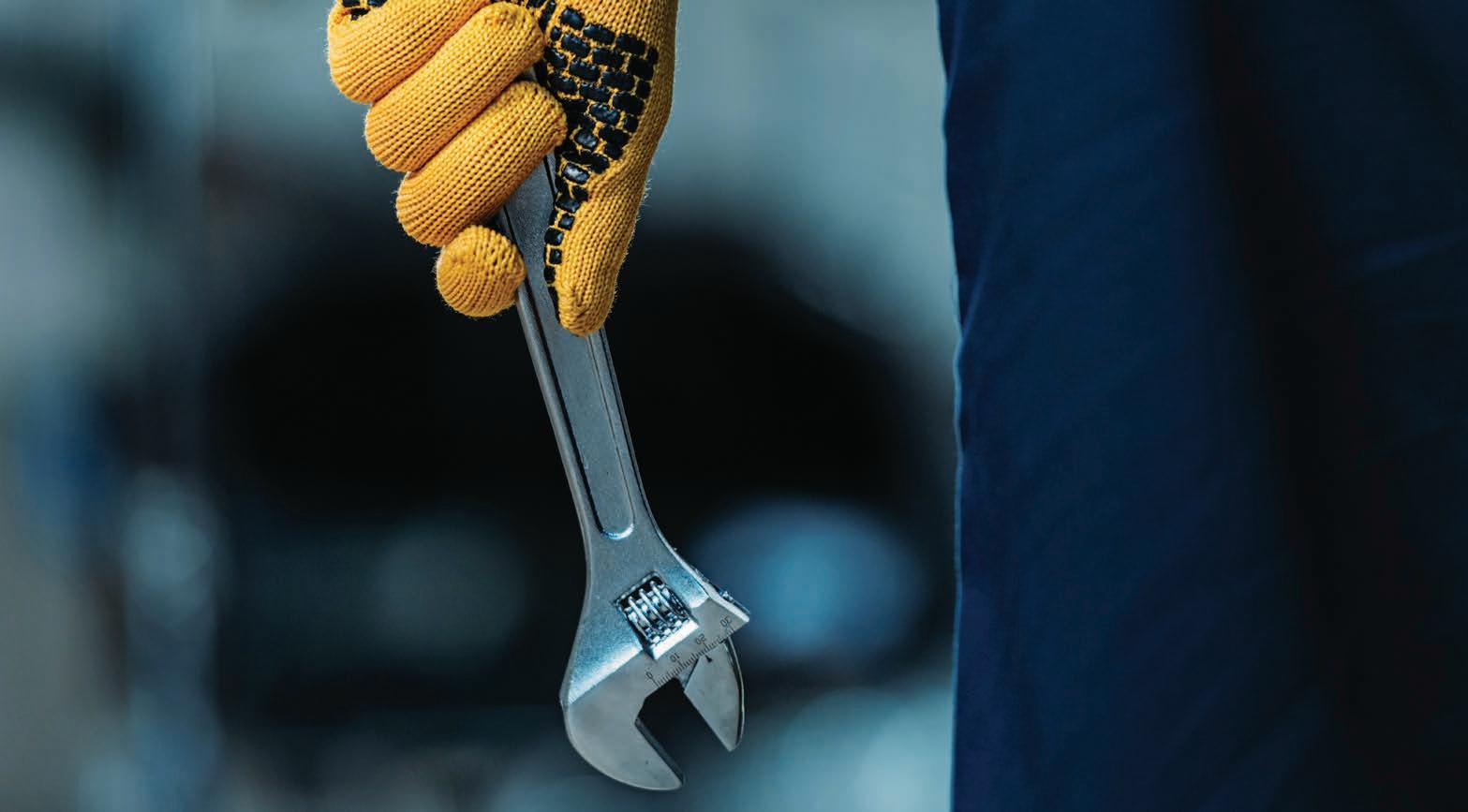
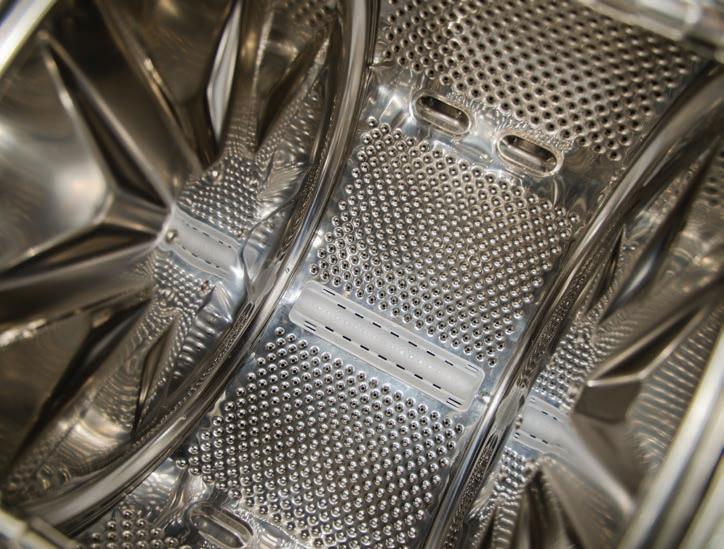
10 FEBRUARY 2023 | American Laundry News www.americanlaundrynews.com
breakdown
Preventive maintenance laundry operations can do with the plant running and with minimal downtime impact or parts costs
(Photo: © Photoerick/Depositphotos)
(Photo: © DmitryPoch/Depositphotos)
It is also widely misunderstood. Consult your manual or reach out to the service department for the specific machine in question.
Be sure you understand the manufacturer’s needs. They love selling parts, but they love a solid and reliable reputation even more.

In maintaining proper lubrication, you reduce wear on many systems beyond shafts, bearings and gears.

Less friction equals less load on motors, drives, belts, etc. This will build extended life into those systems, reduce utility costs, and lighten your load and stress in doing so.
CART SAFETY
I do not like carts (and that’s putting it mildly). Other than caster maintenance and cart repairs in general, carts seem to be the most destructive force known on the planet.
It’s definitely the most destructive force in a laundry. More destructive than apron strings even!


Seriously, though, fabricating and installing bollards and curbs and guards to protect equipment from carts seems to be an endless task at laundries.
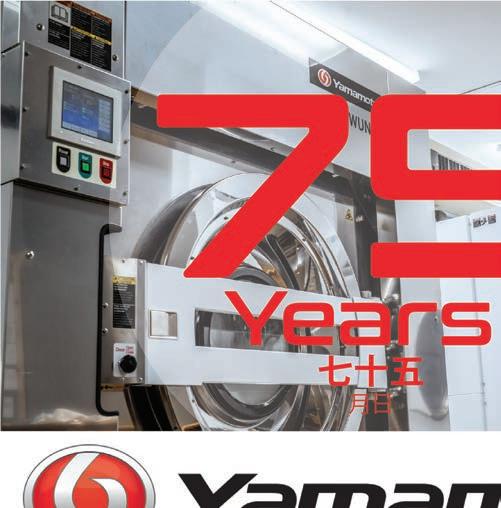
Beating the cart to the touch-screen controller and E-stops is a constant challenge. Always be looking!
FREQUENCY DRIVES

These are becoming less easy to source and often can be time-consuming and painful to program on replacement.



We like to use a vacuum to pull lint
and dust out a couple of times a month or every other week.
This is something that should be done every time you vacuum a control cabinet. I say vacuum because air tends to push debris deep into the drive or contactors. This, however, is not enough—at least in my world.
Dust, and especially lint, will tightly compact itself into the heatsink fins and your frequency drive will begin to overheat. This absolutely reduces the life of these drives.
When you can power down these units for at least an hour (they have capacitors that hold stored energy in many cases), do this. Then, you can strip the drive in segments and use air in conjunction with the vacuum to remove all of this life-robbing debris.
If you have multiple repeats of the same frequency drive (I have a ton of F7 drives in my plant), then build a cheat sheet for setting parameters and keep a spare on hand.
Newer equipment tends to have integrated mini drives in the cabinet, so keeping them as dust- and lint-free as possible is very important.
WEATHER CONSIDERATIONS

As I write this, winter is here. It hit us, and much of the country a little harder
and earlier than we expected.
Winter demands an entire set of preparedness and prevention. Water lines and potential freezing/bursting are obvious, and you probably already have dealt with this and have built-in countermeasures in place.
What about your fire suppression? Our sprinkler contractor comes in every September for a “low point drain” of our system.
In many municipalities, such as ours, the annual inspections and maintenance must be done by a third party that is certified. This is expensive but so worth it.

A dry system, even if it has not tripped, will build up condensation inside simply by being pressurized by compressed air and subjected to wildly varying temperatures, like what you would expect in an ironing room.


I have dealt with a couple of failures of these systems. One was annoying; the other was quite painful.

I will say that I have seen how quickly a well-serviced suppression system can quickly arrest what would otherwise be a devastating fire.
Another winter frustration is frozen air lines and actuators. Most of us have air dryers and oilers on our equipment.
You see water stacking up in the bowl,
and you drain it, and the world is good, right? Well, that water was delivered to that bowl from somewhere.
We have a relatively new and well-sized air dryer immediately after our plant compressor. We live in the Northwest, so our air is wet. We extract about 4 gallons of water a day at this point.
Many of you (and us, previously) do not have an air dryer. That moisture is going to your accumulation tanks, and even if you are diligent about draining those, your supply lines will carry some moisture.
Even with the air dryer, we still drain the tanks, and we still get some moisture in our lines.
Winter exacerbates the problems of moisture in your system, but moisture is a problem year-round. Pneumatic cylinders and actuators will suffer a premature demise from the moisture ruining piston seals and clogging ports.

Alcohol can be used to help dry these systems, but if your subsystems are not using lubrication at the separator, this can accelerate the drying out of all the rubber seals associated with pneumatic systems.
I like to replace poly lines every couple of years, sometimes pulling the lines apart at lower points to push built up moisture out by charging the system. This has helped me.
I also have begun installing “dirt lines” on new systems. Essentially this is just a drop like you would see on a gas line or a

11 American Laundry News | FEBRUARY 2023 www.americanlaundrynews.com
The Newspaper of Record for Laundry & Linen Management Find what you’re looking for wherever you are. Stay on top of the latest industry news and updates on your tablet, phone or in your mailbox. www.american laundrynews.com Experts share insights into how operators can attract, and retain, younger staff members Group acquires Linen King H Hiring next-generation laundry employees LATE NEWS 0223aln_ALN Digital Edition_Jr Half.indd 1 1/13/23 11:02 AM See Maintain on Page 18
EVERY PLANT IS GOING TO HAVE DIFFERENT NEEDS IN THIS ARENA, AS WELL AS VARYING LEVELS OF COOPERATION WITH OWNERS, PLANT MANAGERS AND HOURS OF OPERATION.
PANEL of EXPERTS
Reinvigorating laundry facility safety


All accidents and fires will result in a poor financial situation for laundries.
OSHA compliances, workers’ compensation costs, lost time, retraining costs, equipment damages and delays to production—all these issues affect the laundry, its customers and the team members (employees).
All leaders should be aware that the safety of their team members is a top priority, period. Communication of safety concerns improves morale and develops a cohesive team!
After over 45 years in the textile rental industry, I have seen my share of laundry fires and accidents; none of them are fun.
To reinvigorate safety efforts for both employees and customers, it must start with leadership.
Safety permeates an organization, and it spreads throughout the company when managers and supervisors are engaged and responsive.
As Arnold Glasow said, “One of the tests of leadership is to recognize a problem before it becomes an emergency.”

This is so true when it relates to safety in the workplace; leaders must be initiative-taking.
To help reinvigorate safety efforts within a company, a safety committee must be active daily, recognizing safety concerns before they become a catastrophe.
At least weekly walkarounds should happen with the committee members identifying potential hazards, noting injury rates, the severity of injuries and the workers’ compensation costs are all lagging indicators.
Leading indicators are the number of team members completing safety training, timeliness of reporting, number of nearmisses and timeliness of corrective actions. Route service reps, office staff—all departments must not be forgotten.
There must be representation on the committee from the service team as they are integral in recognizing hazards at customers’ locations. The local fire department is a reliable resource as well as safety consultants to round out your safety team.
During my time at Wagg’s Linen & Uniform, we experienced two significant fires.
One was laundry bags dried at the end of the day and automatically dumped into a cart. During the night, they ignited and caught fire, burning a conveyor belt. We later learned that the “cool-down” on the
dryer was not sufficient to cool the laundry bags.
The other fire was caused by soiled shop towels stored in an overhead sling over the weekend, and spontaneous combustion caused them to catch fire.
We rectified that by washing the shop towels (and leaving them in the washer) before leaving for the day to avoid that hazard. Thankfully, we had a sprinkler system that nullified the damage in both instances.
Again, leaders must take responsibility for everything that happens in the company, and safety is no exception. Safety must not take a back seat, or you will not be in business.
lish a clear vision and set of values that prioritize safety. This includes identifying the specific behaviors and practices that are necessary to ensure the safety of everyone, every day.
Communicate your safety vision. It is important to communicate your safety vision to all employees and stakeholders. This can be done through regular meetings, training sessions and other forms of communication. Just like writing down a new year’s resolution helps you keep it (longer), so, too, does purposefully communicating your safety vision.
Lead by example. Management and leadership must model safe behaviors and practices and hold themselves and others accountable for following safety protocols.
tion. This can be done through various methods, such as safety awards or recognition programs.
Kemco has been recognized with the SafeTRSA award for its safety leadership because of programmatically developing our safety culture. By following these steps, you, too, can build an effective safety culture that promotes the well-being and safety of all employees and stakeholders. A strong safety culture not only helps to prevent accidents and injuries but also fosters a positive work environment and enhances productivity and performance.
Building an effective safety culture requires the commitment and collaboration of all employees, from management to front-line workers.
A strong safety culture is characterized by a shared set of values and behaviors that prioritize safety in all aspects of work.
Define your safety vision. The first step in building a safety culture is to estab-

Involve employees in safety decisionmaking. Encourage employees to participate in safety committees and to speak up about any safety concerns they may have. This not only helps to identify and address potential hazards, but it also fosters a sense of ownership and commitment to safety among employees.

Provide ongoing training and education. Include both formal training programs and informal opportunities for employees to learn about safety practices and procedures.
Recognize and reward safe behaviors. Actively reinforce, recognize and reward the importance of safety in the organiza-
Isn’t it quite interesting that no matter what side of this industry we are all in, whether it is a laundry or a distributor/ manufacturer like us, in times like this where we are all looking to save money whenever we can, you sometimes wonder where you might be sacrificing certain things to make sure that you are a profitable company?
When I say, “isn’t it interesting,” that doesn’t necessarily mean it’s a good thing.
12 FEBRUARY 2023 | American Laundry News www.americanlaundrynews.com
“I’ve been seeing more news reports on laundry fires and accidents, and I am concerned safety has taken a backseat to staying in business. How can I reinvigorate our safety efforts for both employees and customers?”
Textile/Uniform Rental
W. Kirby Wagg Performance Matters, Orillia, Ontario
Equipment Manufacturing
Tom Vanden Heuvel Kemco Systems, Clearwater, Fla.
Equipment/Supply Distribution
Ross Sanders Streamline Solutions, Orlando, Fla.
(Image licensed by Ingram Image)
Sorry to say but sometimes we all look at certain things within our business and then fail to look at others the way that we should.
Yes, we have heard about the fires and the other issues that have occurred at our laundry customers’ plants. When we hear and read about them, we certainly feel their pain as they have spent so much time and energy over what has been many generations to have terrible situations occur at their plants.

What also makes it tougher in today’s world where there has been a good amount of turnover (and it’s harder to find employees, let alone, high-quality ones), it sometimes means that your current and new employees must constantly be trained on all aspects of their jobs, including safety. This would be the case at laundries, at their respective customer facilities as well as at companies like ours.
As a company, we will always remind our employees of what needs to be done to make sure that all angles are covered in regard to safety, whether that means for fire, potential flooding issues or individual employee safety.
All required notifications will always be posted as well as others that we as a company feel are beneficial to keep everything up to date and interesting.
We feel that as a “close-knit” company, employee-wise, we always try to look out for each other’s best interests. We also know and continue to remind each other that whatever we do to help each other out, it always benefits the company and all parties involved.
That’s not to say that we have not had issues through the years, but we quickly implement any needed changes and requirements to hopefully avoid any safety issues that may occur down the road.
Regarding our customers, we have an extremely tight relationship with many of them and because of that, we can be honest with each other if and when we see potential issues arise. We discuss them with each other.
One of the first things that I personally notice, and always will, is how clean a laundry looks. Not that a clean laundry guarantees anything, but it is certainly a good starting point for making sure that a clean laundry is a safe one.
Also, as a company that recycles plastic bags at many of our customers’ plants, we always try to stay in contact with them to make sure that our recycling equipment is safe and in working order.
We require them to have yearly maintenance done to our balers to make sure that everything is working correctly and, of course, to verify that all safety requirements are met.
As I mentioned earlier, in times when there are many changes in employees who handle this part of the business for the laundries, we feel that this is a key part of making sure that all employees are kept safe when working with a large piece of equipment that they normally would not have experience in using.
In conclusion, no matter how things are going financially at your respective businesses, none of us can afford to sacrifice the safety side of things. It would only be detrimental to your business and your employees.
All safety bases must always be covered!
Uniforms/Workwear Manufacturing
Baby it’s cold outside! That was the battle cry this most recent Christmas holiday week when our daughter was home for the holiday visiting from Florida.
For those of you who were not impacted by this unusual polar vortex, temperatures here in Northeast Pennsylvania with wind chill were at a balmy -25 F.
Unbelievably, we even had ice forming
on the inside of our windows. With those abnormal temperatures, our daughter with her blood having thinned out by living in Florida began her search in our house for the space heater we had in storage to help add some warmth to her bedroom.
Once her search was complete, without removing the dust collected from not being used over the years since she relocated to the land of sun and warm weather, she happily plugged the rarely used space heater into the electrical socket.
Soon after the magical warming unit was plugged in, sparks started to fly as the dust balls gathered on and inside the filters caught fire.
On seeing sparks and smelling smoke, I started to think about what are we, as laundry operators, doing to prevent fires and small stupid electrical incidents in our plants?
What are we as laundry operators doing to keep our employees warm and safe during these cold winters while at work or even at their homes?
What are we as laundry operators doing to educate our service team and our customers on proper storage of product so as to not place it in areas that may cause unexpected fires?

Every laundry must have a safety team in place with a checklist that is given its utmost attention to detail. The safety team should set a schedule for when to meet to discuss all items of concern that are dealt with and corrected on a timely basis.
To avoid fires in the plants, it is the responsibility of our safety and top-notch maintenance teams to make sure the air filters are changed and replaced regularly.
That we have in place procedures that require blowing down and removing all dust and lint that tends to build up on machinery, overhead pipes, and even in some cases, inventory in our storage areas.
Also, let us not forget the roofs on top of our buildings. We need to make sure any possible lint buildup is removed as well, as we have seen fires start on rooftops from
gathered lint never removed.
By checking these few little steps off our checklist, we are taking the possibility of any lint fires out of the equation.
Also, being a realist, some laundry operators have cold spots in their plants, and employees have been known to plug in space heaters to keep them warm at work during the cold months.
In these cases, we need to make sure there is no lint gathered on the heaters and also that these heaters are not close to anything considered to be a combustible item that can cause a spark that can turn into a fire.
Is there any way heat or steam being vented out of our buildings be recycled back into the building? If so, we should do so. Not only will this help keep the temperatures at a comfortable working level, but it will also add to a more environmentally friendly workplace.
What about our fleet of trucks? If parked inside the building, do they need to be plugged into wall sockets so engine blocks do not freeze during the cold weather? If so, we need to make sure wires are all properly grounded so there is no chance of any possible sparks that can also be the culprit of an unsolicited electrical fire.
Let us not forget about our employees and our customers. We also need to educate them on ways to keep warm at home by changing air filters and if they are using space heaters, not to place them near curtains or anything that can catch fire easily.
If they have wood-burning fireplaces in their homes or places of work, make sure they have proper ventilation and make sure there is no chance of any sparks being emitted from the fireplace that can cause a fire. A little education goes a long way to preventing fires.
We should also consider empowering our employees to report all fire and safety hazards every week to the safety committee so they can be dealt with immediately.
13
American Laundry News | FEBRUARY 2023 www.americanlaundrynews.com
Scott Delin Fashion Seal Healthcare, Seminole, Fla.
See Experts on Page 15
Supplier experience, relationship strengthens customer value
Rental Uniform Service touts partnership with UNX-Christeyns to create customer-pleasing wash formulas

GREENVILLE, N.C. — Longevity is an admired hallmark of a successful business. Now in its 74th year of operation, Rental Uniform Service has reached this point by making deft and correct decisions time after time.
One of its recent pivotal moves was selecting UNX-Christeyns to return as its washroom chemistry partner, a decision that has produced significant benefits in a short window of time.
“We began a review of our wash chemistry situation in late 2021, did extensive research and narrowed it down to two companies that we met with personally,” recalls Danny Lawrence, longtime CEO of Rental Uniform Service.
“It was remarkable that cost-wise, there was not much difference between the two. But it was evident from the beginning the UNX-Christeyns folks genuinely wanted our business, and they had the technology and service we were looking for.”
Rental Uniform Service has an intriguing history.
The North Carolina-based, family-owned company began as a small operation in Bluefield, Virginia, with a 2,000-square-foot building and one truck in 1949.
James E. Waggoner and his brothers sold many of their possessions to fund their startup and steadily grew their business with persistence and a sincere dedication to their customers.
Today, Waggoner’s legacy lives on. His four daughters serve as the company’s board of directors and other family members hold vital roles.
CEO grandson Lawrence is married to Paula, the company’s controller. Robert King, the director of corporate development, is the husband of Waggoner’s granddaughter, Susan-Hager-King.
And Holly Benfield, the director of human resources, is Waggoner’s greatgranddaughter.
When Benfield joined the company out of college in 2007, she became the first fourth-generation family member to serve on the management team at Rental Uniform
Service. That is an impressive accomplishment few companies can claim.
According to Harvard Business Review statistics, a staggering 70% of family-owned enterprises either fail or are sold before the second generation becomes involved.
Lawrence emphasizes that having family members learn the business from the ground up is one of the keys to why Rental Uniform Service has been successful for so long.
“I’ve been in the linen and uniforms industry my entire life,” he says. “I became a full-time employee here in 1978 after working in the plant for my apprenticeship.
“I was promoted to assistant plant manager in 1981 and promoted to general manager at our Sunshine Rental Uniform Service facility in Gastonia in 1988.”
Lawrence has guided the company as its CEO since 2000.
About the time he was elevated to assistant plant manager in 1981, UNX-Christeyns first became a Rental Uniform Service supplier. Known then as UNX—which merged with and became UNX-Christeyns in July 2022—it became involved during a growth spurt.
“I was heavily involved in the washing technology operations at that point,” acknowledges Lawrence. “It became apparent their service was always quality oriented and their pricing was fair. The relationships we had at that time were second to none.”
Those moments were remembered during the recent selection process.
Rental Uniform Service is now a more diversified organization with 145 employees. It utilizes 200,000 square feet of space between its headquarters in Statesville, North Carolina, a processing facility in Gastonia, North Carolina, and distribution centers in Mills River, North Carolina, and Florence, South Carolina, putting it in favorable proximity to an expansive client base.
Management also operates an employeefriendly schedule, running 10-hour shifts four days a week.
Rental Uniform Service also understands that working with the food, healthcare, hospitality and manufacturing industries, as
well as government, municipalities and others, requires different and specialized wash formulas for each.
“We provide the highest quality product for our customers,” explains King. “That involves utilizing good modern chemistry with natural soap.”
After working for General Electric, he joined Rental Uniform Service in 1999, first in sales before switching to marketing and then as the general manager in Gastonia.
King has been instrumental in growing the company’s sales and technology efforts in his current position.
“We wanted the highest quality product possible, so the goal was to create advanced wash formulas that were unique to each of our customer segments,” he continues.
“For example, we partnered with UNXChristeyns to develop a low pH dispensing formula. In simple terms, since the wash cycle environment is less harsh, the goods are going to be brighter, they will last longer and they are going to wear better.
“We have always been known for the quality and comfort of our garments. Now, with skilled input from UNX-Christeyns, we have been able to achieve an even higher level of comfort and appearance for our customers. This innovative treatment environment makes it better, and we didn’t have that process prior to working with them.”
King acknowledges that working with an experienced, technically proficient UNXChristeyns staff generates better results.
“They have a smart group of laundry industry professionals. People like Graham Skinner (vice president of field engineering) and others who have actually worked in our industry and know what they’re doing,” he says.

“Their area supervisor, Nicholas Vangelakos, visits our plants regularly, and we consider him like family. He’s developed a trusted work relationship with our facility managers.”
King adds, “UNX-Christeyns was able to provide significant efficiencies by reducing the number of steps in our wash formula processes from the beginning to the end.
They’re making sure we are being trained properly on their equipment and making any necessary adjustments.
“They also just finished constructing a unique rack system for the chemical dispensers, which provides efficient product injection while reducing mechanical components. The end result is we have a better looking and cleaner product, in addition to the tangible benefits of using less energy, natural gas, electricity and water.”
Those benefits include improved effluent (wastewater), which is always an important goal for industrial laundries. They have provided real-time, in-house reporting capability that tracks pertinent management data, such as determining the cost-per-load and other vital daily production numbers.
King says that looking at the big picture, it’s better chemistry with UNX-Christeyns that ultimately benefits its customers.
“You can get a uniform from anybody, but what our customers get from us and our vendor partners is better service and quality that can’t be found elsewhere,” he points out.
“Our customer’s expectation is they want a clean and comfortable product, not one that was run through a solvent process.
“We invest more money than most of our competitors because we require our wash process to deliver the highest quality product for our customers. They know we have an experienced service team that is providing the best care in the industry.
“We treat our employees and partners like family, and that’s why many of them have been with us for three decades. That is what truly impacts the relationship with our customers, not just numbers on a page.
King concludes, “Some of our most loyal customers are those who have previously used our competition. Once they experience our superior quality level, the dramatic differences become apparent, and we never lose them.
“Thus, we are pleased that we have found a solid partnership with UNX-Christeyns. They get it. They have the same goals and with their support, we make happier customers.”
14
UNX-Christeyns Area Supervisor Nicholas Vangelakos (center) visits Rental Uniform Service’s plants regularly. (Photos: UNX-Christeyns)
FEBRUARY 2023 | American Laundry News www.americanlaundrynews.com
Rental Uniform Service says its wash cycle environment is less harsh, goods are going to be brighter and will last longer, and they are going to wear better.
Experts
Continued from Page 13
Those who take part in this process should have their names entered into a weekly lottery to possibly win a prize or even a small bonus. By doing this we create a safer workplace, increase morale and have many eyes keeping watch to prevent unwarranted fires.
Oh, and by the way, right after the Christmas holiday our daughter was back in her car driving back to the land of sun and fun. She did arrive safely and the last time we spoke, she was hanging out at her pool sipping a cold drink. I am so jealous. As a wise bear once said, only you can prevent fires!
•Make sure your dryers are maintained properly.

• If the linen smells of grease or oil after washing—do not dry—wash again. Doing these things will show your employees your commitment to safety and communicate why the buildup of lint can cause fires and linen left in carts can spontaneously combust.
Discuss safety at employee meetings. Provide updates on where you are with safety. Solicit feedback and suggestions from your employees on how to be safer. Invite experts to talk about safety and give training. Chemical use is one—your vendor can provide proper chemical use training and explain SDS sheets.

Ensure your employees have proper attire and PPE for the jobs they are doing. Again, with chemicals use, your chemical vendor can assist with this.
Remember a safe business is good for business.

Extra signage, safety shoes, rags, and mops at the ready, and daily inspections for any machine leakage, should be “top of mind.”

We need to show how much we care for our staff and customers by training them and protecting them. It is to the business’ advantage in a financial sense as well due to the large claims that are paid out annually and, on the back end, larger insurance bills due to the accident.

In addition, create a positive attitude by putting safety in a primary position of importance with a program with employees. Contests with simple rewards work very well.
I have seen some have a “safety wall” and saw one large laundromat with a PPE (personal protection equipment) vending machine for both employees and customers.
Of course, making sure that all communication is in the language(s) of both our employees and customers is vital. You might even have a trusted employee give a short presentation on how being safe has impacted them.
they had their employee smoking area outside the laundry with a table and ashtrays set up right next to the dryer vents!
The overriding point is that fire and standing water safety in and around the laundry is a constant item for concern, inspection and action.
You must commit yourself and your managers to a culture of safety to get your employees to also do so. Your commitment to safety needs to be visible for your customers to also follow suit. Safety needs to be an integral part of your company’s culture. Using laundry fires as an example, here is what you can do:
•Train your staff on the location and use of fire extinguishers.
•Don’t overload your dryers.
•Always use cool down.
•Don’t stuff laundry carts with either washed or dirty linen and let them sit overnight—spontaneous combustion could occur.

•Empty dryers at the end of the day.
•Clean lint traps after each load.
•Ensure your laundry is clean and free of lint—clean daily.
Iwas walking around at the Clean Show ’22 and visited a booth on insurance for laundry and was asked the question whether I did any F&B.
If the answer was yes, due to the grease, they would not be interested in covering me unless I provided very detailed information on how I was handling and pretreating the napkins and kitchen rags. This certainly indicates how prevalent and important potential laundry fires are to each owner.
In Grainger’s list of the top 10 OSHA violations of 2022, fall protection is No. 1 just as it was in 2021, 2020, 2019, etc. We work in a water-rich environment, so there cannot be too much attention paid to slip-and-fall accidents.


























Having our staff read and sign, “A Job Hazard Analysis (JHA) form is an excellent means of emphasizing safety’s importance in our business. Job Hazard Analysis (JHA) is a method for identifying and evaluating hazards associated with tasks (steps) with a specific job or activity and eliminating or mitigating them prior to conducting work.” (This can be found via Google.)
How can I reduce the risk of fire in my laundry room?
Not once a month, or even once a week, “Clean the lint from the dryer’s lint screen after every load,” says Richard Handel, the test engineer who oversees CR’s laundry appliance lab.


“This helps prevent a fire, and it also helps your laundry dry faster.”
At the end of the day, take a walk around the business. Look for signs of fire risks, signs of smoke or scorching. If so, you may need to take certain equipment out of service for a time.
This summer I stayed at a hotel, and


As business leaders, we never want anything bad to happen to our workforce or our business.


To realize this goal, though, we must stay diligent and make safety a forefront focus within our operations.
Some ways that we can achieve this is by sponsoring and leading regular safety walkthroughs as part of a safety committee, making sure employees have the right tools to complete their work and that they are stored in a clean and orderly manner, rewarding employees for safe behaviors, and most importantly never stop training your staff on the proper and safe practices to follow throughout your facility.
Fires, unfortunately, have made the news more as of late and, unfortunately, this is one of the greatest risks within a laundry.
There is nothing more important within your facility to prevent fires than proper PMs (preventive maintenance) on machinery and regular blowdowns. If you are not already using software to help automate your PM generation and scheduling the necessary blowdowns, there is no better time than the present to get started!
If you didn’t already know, 40% of businesses that experience a major fire don’t reopen. It’s better to take the time upfront and blow down all the excess lint and dust than to be worried about rebuilding and or recovering from a devastating fire.
15 American Laundry News | FEBRUARY 2023 www.americanlaundrynews.com @AmericanLaundryNews facebook/americanlaundrynews www.americanlaundrynews.com FOLLOW US on Facebook & Twitter Share Our Content Tell Us What’s on Your Mind 092722 KE 4.75x4.75 JR_OL.pdf 1 9/28/22 11:16 AM
Healthcare Laundry William Muse United Hospital Service, Indianapolis, Ind.
Consulting Services Cliff Beiser Champions Touch, Kissimmee, Fla.
Chemicals Supply John Schafer Diversey, Fort Mill, SC
BY MATT POE, EDITOR
Small-Capacity Washer-Extractors
the rear of the machine, tapered roller bearings to ensure extra durability and a continuously welded frame that prevents concentration of stress in one area.
The exclusive RinSave® water saver feature eliminates one to two complete rinses per formula, resulting in up to 0.4 gallons per pound of water saved and faster-processed linen. The feature allows a precise G-force to sling the wash liquor out of the goods after a wash step.
Plus, simple hot- and cold-water inlets are used to quickly fill the washer without fill level overshoot.

The easy-to-use MilTouch™ control offers complete programming flexibility on a clear and informative display. Formulas can be developed on a PC, saved to a USB drive and uploaded with a screen touch.



RAMCO LAUNDRY MACHINERY INC.

RAMCO says its 60- and 80-pound hard-mount washer-extractors have a sturdy hard-mount design that will last a long time in the industry with no floor damage. The company adds that these washerextractors are highly economical choices for smaller hotels and facilities, featuring:
• 304 Stainless Steel Construction— The drum, shell, front and side panels are made of 304 stainless steel.
• Bearings—The heavy-duty spherical rollers are designed to be durable and keep the machine quieter when running.
• Construction—Single-motor variablespeed drive for optimized performance.
• Lip Seals—All seals use radial shaft seals which ensure long-lasting service.


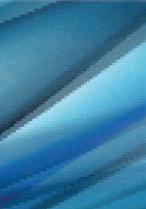

• Large Door Opening—The large door opening makes loading and unloading easier.

RAMCO Laundry Machinery Inc. has been a worldwide provider of commercial and industrial laundry systems since 1986, offering a complete line of equipment, parts, repairs and services.

RAMCO’s specialists offer expertise in equipment selection, facility layout, engineering and support services tailored to each customer’s needs.
www.ramcolaundry.com
800-878-5578
PELLERIN MILNOR CORP.

Milnor says its 36026V5Z 100-pound rigid-mount washer-extractor offers high wash quality and savings on water, energy and total cost of ownership for laundries of all industries.

The machine’s rugged design consists of the NEMA Premium® efficient inverterdriven motor, safe chemical injections in
The control also features intuitive fault diagnosis and relevant troubleshooting suggestions to help eliminate operator guesswork.
www.milnor.com

504-712-7656
DEXTER LAUNDRY
Dexter Laundry says it is committed to building more than just laundry equipment; it’s here to help laundry businesses achieve long-term success while providing top-of-the-line laundry solutions that operators can depend on for years to come.
The company offers a full line of onpremises washers and dryers that are designed and built in the United States.
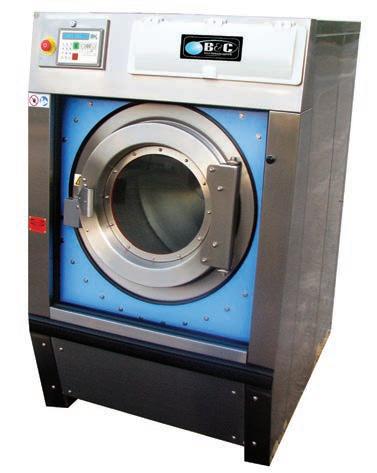



Dexter adds that it is continuously looking for ways to help make operations more successful and provide solutions that better needs. In that light, the company is launching its all-new Express Plus S-975 (60 pounds) soft-mount washer.
Built with over 128 years of engineering, the S-975 (400G) is built to show up to work every day and offers total control with O-Series including 100 fully customizable cycles, according to Dexter.
The rugged internal suspension system allows this soft-mount washer to be installed in locations that can’t support a traditional hard-mount machine. Plus, the flexible design reduces installation time without sacrificing the quality expected from Dexter Laundry.
As always, the company says this model is backed with a 10-year warranty and lifetime technical support.
www.dexter.com
800-524-2954
remarkable results.
With a 20-pound load capacity, the PWM 908 is the perfect solution for smallcapacity wash needs in hotels/motels, catering services, care facilities, small businesses, special applications like marine and fire brigades, and homes, the company says. Wash performance with 50+ customizable programs is available, including a thermal disinfection program that achieves 99.99% disinfection.
Miele adds that high-quality performance for residential and commercial use, eight hours a day and 365 days a year, has been tested with a durability of 30,000 operating hours.
Miele Professional concentrates on the manufacturing of commercial products for industries using commercial dishwashers, commercial laundry technology and laboratory, medical and dental technology. Wherever innovative high-end products with outstanding cleaning performance and high hygiene requirements are needed, Miele Professional says it wants to be the first choice.
www.mieleusa.com/professional 866-781-5053
MIELE USA
Experience a sustainable laundry solution that reduces resources and operating costs. Miele Professional says the Little Giants washing machine offers user convenience and flexibility, intelligent water intake controls, short cycle times, and


B&C TECHNOLOGIES

B&C Technologies says its HP hardmount professional washer line has been proven in the field to offer long life and dependability.
Available in 65-, 85- and 125-pound capacities, these machines utilize a simple design that saves money by keeping repair costs and downtime to a minimum and allows for easy maintenance.
The high extract speed of the HP line ensures less dry time for goods saving on utility costs and wear and tear on the goods, according to the company.
All B&C washers feature a solid founda-






































16 FEBRUARY 2023 | American Laundry News www.americanlaundrynews.com
PRODUCT SHOWCASE
COMPILED
RAMCO LAUNDRY MACHINERY INC.
B&C TECHNOLOGIES
DEXTER LAUNDRY
MIELE USA
PELLERIN MILNOR CORP.
tion, a large door opening for easier loading and unloading, and a strong door and hinge system made of 304 stainless steel. Based in Panama City, Florida, B&C Technologies says it focuses on an engineering-driven design to manufacture laundry equipment that is durable, reliable and built for long life while maintaining a low cost of ownership.
www.bandctech.com




850-249-2222
washer-extractor features a patented Water Droplet perforation pattern of the drum that enhances mechanical wash action, improves water extraction and reduces linen damage.

The Concave-Convex texture design provides an extra layer of rubbing force to increase mechanical power, effectively improving cleanliness.
In addition, during extraction, the raised droplets deter linens from being forced out of the perforated holes while creating an easier path for water to escape.
The company says its unique Water Droplet drum design creates a smooth washing surface, gently lifting the load, improves water extraction, and reduces snagging and fabric damage.
www.sealionamerica.com

860-316-5563
UNIMAC
UniMac says that for decades, laundries that are focused on exceptional throughput and the lowest cost of ownership have looked to its 65-pound capacity UWT065 to carry the load.
This on-premises laundry workhorse boasts a variety of features to produce quality results while reducing operating costs.
SEA-LION AMERICA
Sea-lion America says its 25kg (55 pound) loading capacity open pocket

The company says this workhorse got a high-tech upgrade in 2022 when it launched the UniLinc Touch control.
The intuitive touch-screen control uses


real words to make it simple to operate, but also offers 34 languages to ensure all staff members can use it. This removes any ambiguity, shortens training time and helps ensure correct cycles are used to protect finished quality.
The new control builds on all the other features that have made the UW an industry-leading product, including an ultra-high 400 G-force extraction to remove more moisture than many other hard-mount washer-extractors, according to UniMac.


In addition, the industry-exclusive OPTispray spray rinse removes more residual chemistry than conventional bath rinses—an equally effective asset for removing soil in pre-rinse steps.
Best of all, the UWT065 bares all the hallmarks of UniMac’s industrial qual-














ity, including a robotically welded frame, oversized bearings and four fast-fill valves.
The company says the results are improved processes, better quality and the lowest cost of ownership.
www.unimac.com
920-748-3121
MAYTAG COMMERCIAL LAUNDRY
The Maytag® Commercial MHN33 Single Load, Energy Advantage™ FrontLoad Washer model has been an industry workhorse for the on-premises laundry (OPL) segment, according to the company.


Key features and benefits of the MHN33 washer include the DuraCore Drive System, an advanced drive system that features a triple-lip seal, robust shaft sleeve, premium bearings and die-cast trunnion.
The advanced spin technology delivers more accurate cycle times and better unbalanced performance, while its sixpoint suspension features four dampers and two springs, providing better stability for the entire wash unit, says Maytag.
In late 2022, engineers ended a sevenyear lab test on the Commercial Laundry MHN33 front-load washers—a test of the DuraCore Drive System that started in 2015 with 10 machines running daily, with proper use and care and adherence to the recommended maintenance schedule.
HOT TOPIC TRIO: Inside Today’s Textiles, Creating Your Laundry Brand, What’s Going on with Laundry Labor
Today’s
Duane Houvener, national sales manager for American Dawn, provides insider discussion about modern textiles and how performance and processability have been improved.


The Laundry Brand

A commercial laundry today, no matter the size, needs to create its unique brand to stand out, and this discussion with Asit Goel, vice president of marketing at UniFirst, will examine what steps to take.

Laundry Labor Update
FREE SEA-LION AMERICA
Every ➢ Page 18



offers UNIMAC
with an expert, including business-building tips

you won’t

17 American Laundry News | FEBRUARY 2023 www.americanlaundrynews.com
Textiles
episode...
engaging, industry-specific conversation
find
Guest Joseph Ricci, president and CEO of TRSA, talks about the current state of laundry hiring/training/retention, offers ideas and looks into the future of laundry labor. Give us a try! Listen in at: americanlaundrynews.com/podcasts 0123aln_ALN Podcast_Tab_half.indd 1 12/9/22 10:48 AM
anywhere else. And you can listen anytime, either online or download for later!
Throughout the ongoing lab test, three of the 10 machines were removed from testing and used at tradeshows to demonstrate the remarkable results achieved while the remainder of the seven machines reached more than 60,000 cycles individually (individual washer dependability may vary in actual use).
This was based on lab testing of the DuraCore Drive System up to 60,000 consecutive 34-minute timed cycles using an 11-pound laundry load on the “Heavy Load” setting.
www.maytagcommerciallaundry.com
269-923-5000
party rental facilities, and more, Yamamoto says it offers the benefits of industrial laundry equipment on sizes ranging from 30 pounds to 275 pounds of capacity.
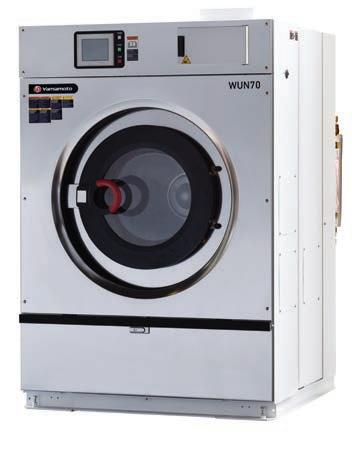
www.yamamoto-na.com
866-653-4408
GIRBAU NORTH AMERICA
Continental Girbau says its high-performance Genius Series Washers—available in 23-, 30-, 45-, 60-, 70- and 80-pound capacities—feature the industry’s largest touch-screen control.

They also reach up to 450 G-force extract speeds for shorter dry times, lower utility costs and maximized throughput; touts a highly programmable control; are Bluetooth, WiFi and IoT (Internet of Things) ready; and feature a 360° Vision™ corner status light so operators know load statuses with a glance.
Maintain
Continued from Page 11
low point drain on a suppression system.
The difference is I install a ball valve and cap that we can open and try to push some moisture out. Seems effective in my world.
Also, about compressed air, if you can walk the plant alone with nothing but the compressor running, I will bet money all of us would hear a leak or two. This is another constant battle.
We feed a beast with two hearts: the boiler and the compressor. It needs both to live. Keep these leaks at bay.
I involve a subcontractor in our annual boiler inspection, and with the cold weather here, we are all conscious of gas costs.
I have one of their crew adjust each burner in our plant on the day of our internal. One good tech can handle our plant in less than a day. Your plant may need a couple of visits, or maybe you have someone on staff that is proficient in using water column gauges and can make these adjustments, in-house, regularly.
I’m not even smart enough to know why a regulator might be out of adjustment half of a turn since the last adjustment, but you can see a visible and measurable change in flame and drying times, etc. if there is a correction made.
IN THE LOOP
Maintenance. Reliability engineers. Chief. It doesn’t much matter the title or the fancy bow we wrap it in. We are a necessary evil, of sorts, to our industry.
Thanks to extract speeds up to 450 G-force and accelerated two-minute rampup to programmed G-force, the company says Genius Washers can boost wash cycle production by up to 22% over lower-speed washers.

The company adds that the GS performance drives down operational costs and increases labor productivity and cost effectiveness with shorter dry times, reduced natural gas usage to operate dryers and extended linen life.
Features include:
YAMAMOTO NORTH AMERICA
The easiest way to understand the engineering behind Yamamoto washerextractors is to think big, the company says. Even though this showcase is on small-capacity equipment, the pictured WUN70 is built for so much more than just 70 pounds of linens.
For example, the dual soft-mount suspension is overbuilt to handle the harshest loads, according to the company. The completely metal, self-serviceable drain valve overpowers the toughest clogs while reducing the cost to own by eliminating unnecessary service calls.
The oversized industrial valves save on fill times, which speeds up processing and increases throughput. Even the bearing comes standard with triple-seal protection and an automatic grease injection line that assures nearly double the lifespan of our leading competitors.
Perfect for hotels, hospitals, nursing homes, athletic facilities, dry cleaners,
•10-inch water-, scratch- and impactresistant touch-screen/operator interface.
•Available on-screen messaging and graphics for operational reminders and preventative maintenance instructions.
•360° Vision™ corner status light.
•450 G-force extract for maximum efficiency and production.
•Maximize labor production through an industry-best two-minute acceleration ramp-up to max G-force even when a load is up to 15% out-ofbalance.
•99-Progams—20 pre-set and 79 customizable programs.
•Onboard battery in case of power loss.
•Bluetooth, Wi-Fi and IoT ready.
•Oversize loading door and full stainless-steel cabinet.
www.gnalaundry.com
800-256-1073
We don’t provide revenue. We don’t sign new accounts. If you are like me, sales and service are something you only think about if they are not happy with quality or volume.
With that said, a plant experiencing good uptime and reliability generally rests directly on our shoulders. Be sure to contact the owner or general manager a couple of times a week. Share with them the accomplishments, and challenges, that the week or month has presented.
A good relationship with ownership is a powerful tool in getting the support you need to not only stay efficient but also to progressively get better. That owner, even if they won’t say it out loud,
will be your biggest fan.
They need you to be successful for them to be successful. We don’t provide revenue, but we surely can provide better margins by being good stewards of their equipment, providing greater volume with less labor.
Your other managers need your ear, too, and if the relationship is good (and life is better for all parties when it is), they can share their concerns about certain equipment, and you can try to schedule downtime for maintenance.
I am fortunate enough to have great relationships with ownership, plant management and production management. None of us can fully understand each other’s position or pressure, but “one team” is an easy sell and the best way to approach all aspects of business, laundry or otherwise.
I’ve said this many times: Listen to those voices doing the work on the floor. These veteran production workers, and even some of the newer ones, can have solid ideas and good intel. Maybe their wishes aren’t always practical, but this “one team” doesn’t run without them.
PERSONAL PREVENTIVE MAINTENANCE
Lastly, everything you just read is simple stuff you have already said and/or heard and done.
Whether you are the owner of a small dry cleaner working 16-hour days, seven days a week, or a chief engineer at the greatest laundry in America or a floor lead, keeping inanimate objects running and producing can suck the soul out of you.
Busy schedules and demanding deadlines will have us delaying a dental checkup or a doctor’s visit. Longevity and experience and loyalty are the most important tools we bring to our companies and apprentices.
Stay healthy so you can keep giving. Let the people you lead feel good about themselves and the job.
Our field recently lost a great engineer. He was smart and kind and dedicated.
Carlos Ramon Espinoza, an engineer with Magic Linen, passed away much too young. I only knew him briefly, but he impacted me immensely.
He is probably making sure the escalator to heaven is running at peak efficiency even as I type.
Continued from Page 4
Burners—keep your burners tuned and operating at optimum levels. This is generally an outsourced task with which your burner manufacturer or equipment suppliers can assist.
Keep your load sizes correct. If your team is underloading, then you’re processing more loads per week than necessary, thus using more of every category of utility and supplies. Proper loading can provide a significant boost in throughput volumes and reduce your operating costs immediately.
The Bottom Line: With the price escalations in utility costs looking like they’re here to stay, we must protect the P&L by managing usage, doing all we can to assure the perunit costs remain reasonable and competitive.
This is not just a task for your maintenance team, so engage all your employees in the effort to contain utility costs.
Tommy Cocanougher is director-operations engineering solutions for Cintas Corp. Western North America and vendor relations rep for European suppliers. He directs engineering, reliability, quality and safety initiatives across 200-plus industrial sites across North America. He has more than 28 years of experience in the industrial laundry industry.
18 FEBRUARY 2023 | American Laundry News www.americanlaundrynews.com
YAMAMOTO NORTH AMERICA
GIRBAU NORTH AMERICA
Column
MAYTAG COMMERCIAL LAUNDRY
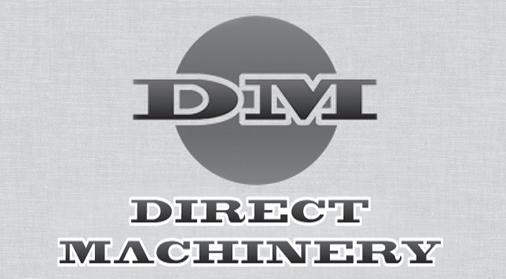







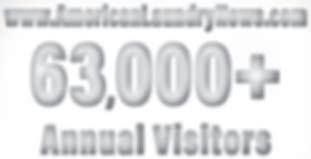













































19 American Laundry News | FEBRUARY 2023 www.americanlaundrynews.com Classified Advertising 2023 CLASSIFIED RATES: One- to fivetime rate: $3.00 per word, boldface $3.05 per word. Minimum charge: $50.00 per ad. Call or write for our six- and 12-time rates. If box number is used, add cost of five (5) words. Display classified rates are available on request. All major credit cards are accepted. DEADLINE: Ads must be received by the 1st of the preceding month. For example, for a June ad, the closing date is May 1st. PAYMENT FOR CLASSIFIED ADS: Must accompany order. DESCRIPTION FOR NEW OR USED LAUNDRY EQUIPMENT, DM IS YOUR SOURCE FOR ALL YOUR NEEDS COMMERCIAL LAUNDRY CLOSING: Milnor 8 Module Pulse Flow CBW/Press with Monorail with slings (5) 64/58 up to 320 Lb Gas System Dryers (July 2015) (4) Chicago Century 2 Roll 52” Steam Ironer (2019), Various years (1) Edge Maxx (2019) (4) Edge, Various years (1) Chicago Skyline 1 Lane (2019) (1) Skyline 4 Lane, (2) Skyline 1 Lane, Various years (3) Air Chicago XXL Blanket, Towel and Gown Folder, Various years (2) Braun Towel & Gown Folders (3) Milnor Soft Mount Open Pocket 140 LB Washers (2015) (2) Milnor M202 Gas Fire Dryers (20015) (2) 500 HP York Shipley Gas Boilers (1) Colmac Connie Lab Coat Presser (3) Quincy Air Compressors Voss 75 Pound Tunnel Washer (1984) Multiple Linen Carts (350) Scissor Dock Lift Portable Scissor Dock Riding Lift For pricing and the latest list call Ron Hirsch 516.938.4300 • 516.315.7426 Hicksville, NY • www.directmachinery.com First Quality Healthcare Textiles Gowns-Bath Blankets-Sheets All at GREAT PRICING!! Call 757-448-8589 The Griffin Group, Inc. “Recruitment Specialist” ® Need to fill a position? Call Deana Griffin 888-235-2365 www.thegriffingroup.cc deana@thegriffingroup.cc USED EQUIPMENT AVAILABLE 1997 Hydraulic Vertical Baler 5868 2011 Fulton 150 PSI Thermal Boiler 5693 175lb ADC Gas Dryer 5867 2002 Chicago Edge Feeder 5827 2000 Chicago Edge Feeder 5835 2003 Chicago Edge Feeder 5830 2011 Chicago Skyline Mini w/Stacker 5821 2005 Chicago Skyline S-13-2000 w/Stacker 5829 2003 Chicago Skyline S-20-2000 w/Stacker 5837 2002 Chicago Edge Feeder 5824 2004 Hamilton EVO II Hot Water Heater 5543 2004 Hamilton EVO II Hot Water Heater 5544 2003 Chicago Centii 42TH Ironer 5684 2004 Chicago 3 Roll Centil 32ST 5831 Norman Lift Table 5677 Norman Lift Table 5678 Norman Lift Table 5679 2002 Pak-Tyer 2000 5615 1996 Chicago Gown Folder 5610 2004 Chicago Slim Towel Folder 5612 1995 Air Chicago Small Piece Folder 5694 2003 Air Chicago Small Piece Folder 5816 2003 Air Chicago Small Piece Folder 5817 2006 Lavatec Press 5571 2005 140lb ADC Washer/Extractor Softmount 5842 2010 60lb Milnor Washer 5658 www.ineedjpequipment.com 800.925.3236 www.AmericanLaundryNews.com 000+ Annual Visitors Advertise Today Contact Don Feinstein • 312-361-1682 MMATS REPLACEMENT COMPUTER BOARDS For Folding Equipment AMKO AMERICA INC. New & Remanufactured Finishing Equipment WWW.JBILAUNDRYFOLDER.COM 561-863-9696 AmkoAmerica@gmail.com Place your ad AmericanLaundryNews.com ONLINE! KEEPING IT GREEN SINCE 1970 STANCO is a nationwide dealer in used and surplus, Industrial Equipment Washer-Extractors: 30# Capacity to 1200# Capacity. Dryers: 100# to 800# Gas or Steam Heated. Ironers: Single and Multi-Roll. Steam, Gas. Folders: Small & Large Piece. 1 to 4 Lane. Sheet Feeders: 4-Station, with or without vacuum. Transport Carts: 24-Bushel Canvas or Poly. Boilers Cooling Towers Heat Exchangers Generators Please visit our website: www.stancoind.com E-mail: buyer@stancoind.com Stanco Industries, Inc. Serving The Textile Trades Since 1970 800-932-3769 Ask for Mike or Deb DISTRIBUTOR OFFERINGS DISTRIBUTOR OFFERINGS EMPLOYMENT EQUIPMENT FOR SALE EQUIPMENT FOR SALE LINENS FOR SALE Advertise Today Contact Don Feinstein • 312-361-1682 Reach 750 + Laundry Professionals American LaundryNews .com More than unique visitors monthly! 8,200
































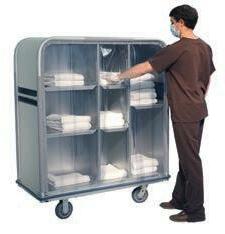

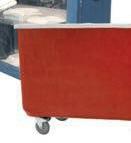














































20 FEBRUARY 2023 | American Laundry News www.americanlaundrynews.com Source Directory listings in American Laundry News are sold on an annual basis at the following rates: All Major Credit Cards Accepted 2023 Listings Regular Boldface All Caps Four Line Listing per Year $1,000 $1,265 $1,265 Display and additional line rates available upon request Source Directory A convenient guide to sources of products and services www.colmacind.com 800-926-5622 Tunnel Finishers Cube CFS 90 “SkinnyMac” Garment Presses Triple Connie Turbo Quality For more information: G.S. Manufacturing 1-800-363-CART (2278) www.gsm-cart.com ...for the Long Haul. Precision built, all welded, anodized aluminum carts, specifically engineered for the extremes of loading, handling, cartwash and off-site transport in your busy laundry. Available in a wide range of models and sizes, and always to your custom requirements. Sani-Trux Carts Deliver a Larger Workload With Less Effort mcclurequotes@gmail.com www.mcclureindustries.com • 800-752-2821 80 different models • Won’t warp • Twice the life span as Poly Carts. • 2000lb capacity Fire Retardant Rated ASTM E1354 • Many different options: caster upgrades, drain valves, bumpers, brakes, P-Locks, gas props, locking doors & push handles. www. AmericanLaundryNews .com PLACE YOUR AD HERE Don Feinstein • 312-361-1682 CONTACT US TODAY! TQind.com | 800.826.1245 | TQcarts@TQind.com Performance Driven PRECISION MADE CARTS Since 1961 as seen at CLEAN ’22 APPAREL FINISHING CARTS, TRUCKS & BASKETS CARTS, TRUCKS & BASKETS CARTS, TRUCKS & BASKETS Advertise Today Contact Don Feinstein • 312-361-1682 Reach 750 + Laundry Professionals American LaundryNews .com More than unique visitors monthly! 8,200 Check out our Digital Edition ONLINE! www.americanlaundrynews.com









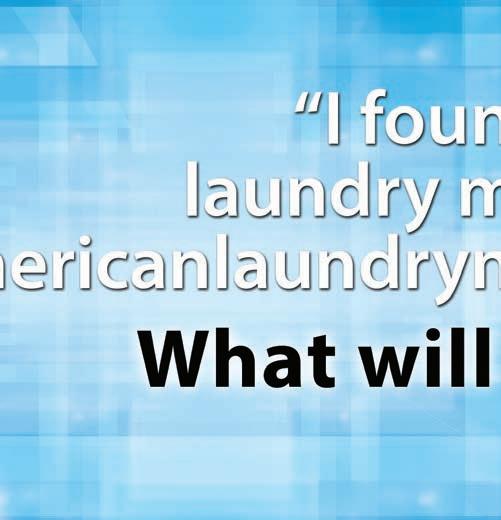



21 American Laundry News | FEBRUARY 2023 www.americanlaundrynews.com Source Directory listings in American Laundry News are sold on an annual basis at the following rates: All Major Credit Cards Accepted 2023 Listings Regular Boldface All Caps Four Line Listing per Year $1,000 $1,265 $1,265 Display and additional line rates available upon request Source Directory A convenient guide to sources of products and services Pellerin Milnor Corp. P.O. Box 400, Kenner, LA 70063 504-467-9591, Fax: 504-468-3094 www.milnor.com Pellerin Milnor Corp. P.O. Box 400, Kenner, LA 70063 504-467-9591, Fax: 504-468-3094 www.milnor.com TO PLACE YOUR AD C ALL D ON F EINSTEIN 312-361-1682 800-826-1245 • cleancyclesystems.com CCS MODELS AVAILABLE FOR ANY SIZE OF LAUNDRY OPERATION OPL Series Utility Free DLF Models Automatic Blow Down LINT LASSO In-Line Lint Filter as seen at CLEAN ’22 COIN/TOKEN OPERATED PARTS DRYER BOOSTER & EXHAUST FANS DRYERS — 100 POUNDS OR LESS DRYERS — 100 POUNDS OR MORE LINT COLLECTORS & FILTERS www. americanlaundrynews .com Place your ad ONLINE! www. americanlaundrynews .com












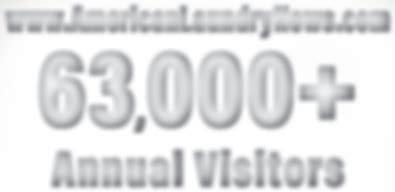

































22 FEBRUARY 2023 | American Laundry News www.americanlaundrynews.com Source Directory listings in American Laundry News are sold on an annual basis at the following rates: All Major Credit Cards Accepted 2023 Listings Regular Boldface All Caps Four Line Listing per Year $1,000 $1,265 $1,265 Display and additional line rates available upon request Source Directory A convenient guide to sources of products and services Pellerin Milnor Corp. P.O. Box 400, Kenner, LA 70063 504-467-9591, Fax: 504-468-3094 www.milnor.com Pellerin Milnor Corp. P.O. Box 400, Kenner, LA 70063 504-467-9591, Fax: 504-468-3094 www.milnor.com Pellerin Milnor Corp. P.O. Box 400, Kenner, LA 70063 504-467-9591, Fax: 504-468-3094 www.milnor.com Pellerin Milnor Corp. P.O. Box 400, Kenner, LA 70063 504-467-9591, Fax: 504-468-3094 www.milnor.com Company Page Company Page INDEX OF ADVERTISERS A.L. Wilson Chemical Co. 7 Direct Machinery 19 GA Braun 9 The Griffin Group 19 J.P. Equipment 19 Kannegiesser ETECH 15 Lavatec Laundry Technology 24 Monarch Brands 5 Pellerin Milnor Corp. 3 Royal Basket Trucks 13 Stanco Industries 19 Yamamoto 11 MAT ROLLERS PRESSES — EXTRACTION SMALL-PIECE FOLDERS TUNNEL WASHER SYSTEMS WASHERS — CONTINUOUS BATCH WASHER-EXTRACTOR — 100 POUNDS OR LESS WASHER-EXTRACTOR — 100 POUNDS OR MORE www. AmericanLaundryNews .com www.AmericanLaundryNews.com 000+ Annual Visitors Advertise Today Contact Don Feinstein • 312-361-1682
Maxon completes construction on second manufacturing plant







SANTA FE SPRINGS, Calif. — Maxon Lift Corp., headquartered here, reports that construction has been completed for its new 422,000-square-foot factory in Monterey, Mexico, and that it has taken full possession of the building.



“The Maxon family is investing $70 million in this plant,” says Casey Lugash, member of the Office of the President. “It’s a huge investment for us and the future of the North American transportation industry.”
Maxon says it already has personnel working in the new building installing infrastructure and production lines.
The company planned on producing the first liftgates in the new factory in January. This production will not only immediately add to Maxon’s capacity, but it will take some of the pressures off the existing facility allowing Maxon to increase capacity on the West Coast.
“With this factory, in addition to our existing factory, which was completed in 2008, we will have the capability to build 100% of the needs of the North American liftgate market,”

Lugash says.
“The completion of this building could not come at a better time, not only for Maxon, but for the entire North American transportation industry,” says Brent Stratton, member of the Office of the President.
“We are seeing record backlogs and lead times across the board in our industry, and Maxon is the only company in our space who has invested heavily in additional capacity. This capacity will revolutionize the liftgate industry and make lead times a thing of the past.”
Once the new factory is fully integrated with all the Maxon product lines, Maxon will have 800,000 square feet under roof dedicated solely to the production of liftgates for North America.
Alliance Laundry Systems Distribution relocates Texas office


RIPON, Wis. — Alliance Laundry Systems Distribution reports that it is relocating its Dallas office to Coppell, Texas.



Previously, the office was based in Farmers Branch.
“I can’t wait to open the doors to our new office to customers,” says Sam Husain, general


manager of the Dallas office.
“Our new facility will enable us to better serve customers.”




The company says the new office, located at 631 Southwestern Blvd., Suite 140, will feature a more convenient pickup area for customers.
Alliance Laundry Systems Distribution in Dallas is a full-service distributorship offering UniMac on-premises laundry solutions and Speed Queen laundromat equipment.

Services offered include factory-trained, in-house install, service and support staff; genuine parts department; financing; laundry design services; demographics; and more, the company says.

In memoriam: Lee Ekola, Kannegiesser ETECH
MINNEAPOLIS — Kannegiesser ETECH reports that Lee Ekola, founder of E-Tech Systems, died on Dec. 15.

He was 88.
Ekola started in the laundry industry at 11 years old, sweeping floors in his father’s American Linen laundry in Hibbing, Minnesota.
His early responsibilities included sorting and folding laundry, loading machines and keeping the plant clean.
After earning his bachelor’s degree in mechanical engineering from the University of Minnesota in 1958, he was promoted to engineer and later to engineering manager.
In 1970 he left American Linen to start Ekola Engineering with his wife, Beverly, which was later renamed E-Tech Systems.
Ekola saw a need for efficient, powerful material handling systems, and at Ekola Engineering, they developed the first track systems to automate laundry logistics, storage and washer loading. As the industry transitioned to tunnel washers, the company transformed its technology to help laundries achieve even greater efficiency and productivity.
In 2017, Kannegiesser USA purchased E-Tech Inc. to form Kannegiesser ETECH.










Calendar of Events
Ekola did not like to be idle. He loved to build things (kitchen cabinets, a picket fence surrounding their home, a garage for his son’s family) and always had his eye out for something to fix, especially at the family’s lake home and for friends.
He loved boats.
Starting in his teens and lasting into his 70s, he built speedboats, runabouts, sailboats and dinghies. He had boats on Lake Harriet and Lake Superior.
Ekola also enjoyed cross-country skiing, biking and volleyball.
In the later years of his life, he was an enthusiastic volunteer with Urban Homeworks.
He is survived by his wife; sisters, Judy Porter (Dave) and Lynne Harrington (Jeff); brother, Dean; children, Susan Caron, Nancy Ekola, Darlene Nye (Steve), Ali Gohar (Jane), Peter Ekola (Carita Zimmerman); and seven grandchildren.
Memorials may be made to Urban Homeworks, which provides quality and affordable housing to Twin Cities’ residents (urbanhomeworks.org) or the Alzheimer’s Association (alzheimers.org).
Huebsch Services receives award for sustainable practices
EAU CLAIRE, Wis., and EAGAN, Minn. — Huebsch Services, a uniform and facility services company based here, reports that it has been honored by Wisconsin Manufacturers & Commerce with the Business Friend of the Environment Award for its efforts in sustainability in the small business category.
Huebsch was nominated by one of its customers alongside 25 other businesses for the award, which was presented in November.




As a member of the Laundry Environmental Stewardship program, Huebsch focuses on reductions in chemical usage as well as water and energy conservation to protect the environment.
The business of renting uniforms and floor mats itself is sustainable, as it re-uses, repairs and maintains uniforms time and time again, with many of these products having a lifespan of several years.
Huebsch says it also focuses on using energy-efficient vehicles as much as possible, reducing its energy consumption. The company even installed a l00kw solar energy system on the roof of its Eau Claire production facility, which provides one-third of the energy needs for the entire building.
Another major project that was completed recently was the installation of a stormwater retention system that holds and treats stormwater runoff to reduce sediments and other pollutants into the ground below the parking lot of their Eau Claire facility.
Huebsch says it is proud to be recognized for its impacts made on the environment and is dedicated to continuing to maintain, evaluate and continue its sustainable practices into the future.
23 American Laundry News | FEBRUARY 2023 www.americanlaundrynews.com
February 1-2 TRSA California Legislative Conference Sacramento, Calif. Info: 703-519-0029 8 TRSA Kentucky Legislative Conference Frankfurt, Ky. Info: 703-519-0029 16 TRSA DEI Safe Space Series: What You Should Know About 3rd Party Harassment Alexandria, Va. Info: 703-519-0029 23 Association for Linen Management Webinar: Combating Rising Costs by Revisiting Laundry 101 Richmond, Ky. Info: 859-624-0177 23 TRSA Virtual Event: Market Sector Conversations Alexandria, Va. Info: 703-519-0029 March 13-15 Association for Linen Management IMPACT 2023 Conference Charleston, S.C. Info: 859-624-0177 16 TRSA Building a New Plant Series: Part 1 - Before Move In Alexandria, Va. Info: 703-519-0029 21 TRSA Supplier Partner Workshop Washington, D.C. Info: 703-519-0029
Maxon’s second manufacturing plant will solely produce liftgates for North America. (Photo: Maxon Lift Corp.)
… SUPPLIER NEWS … INDUSTRY EVENTS …
AWARDS AND HONORS … FINANCIAL REPORTS … EKOLA
TRADE TICKER…
